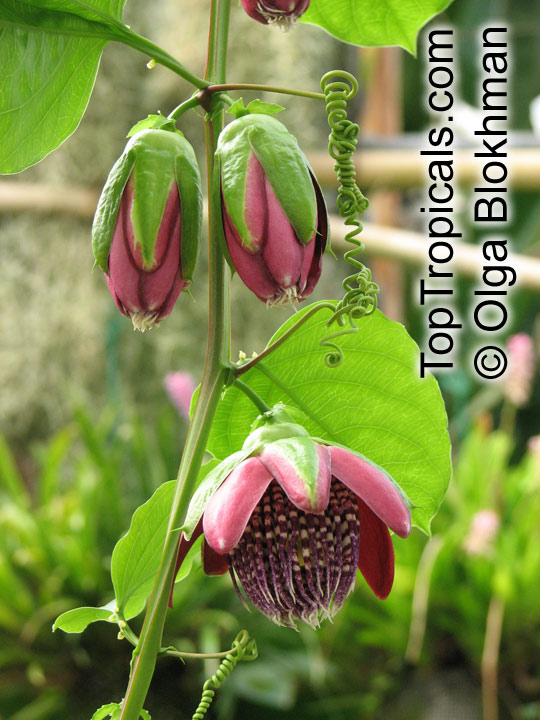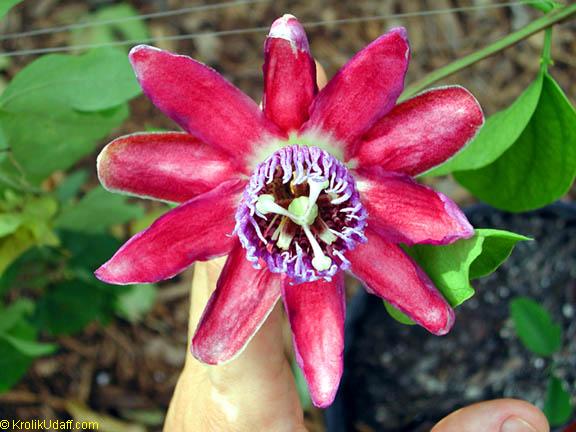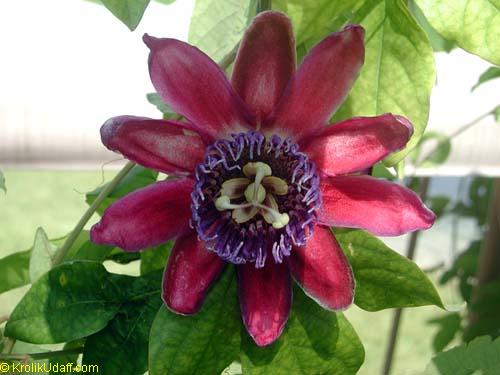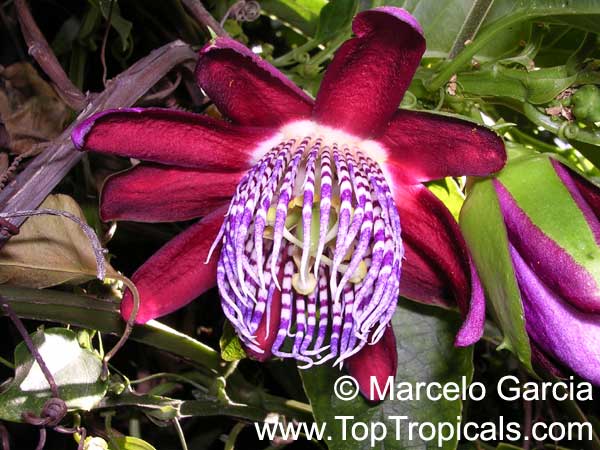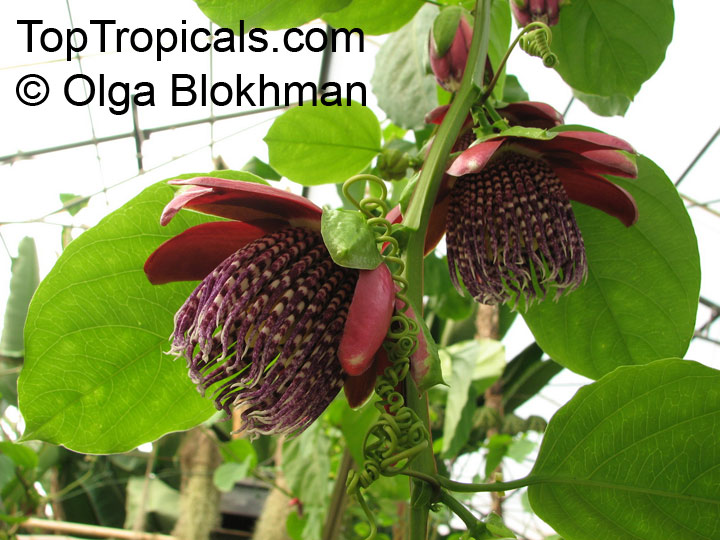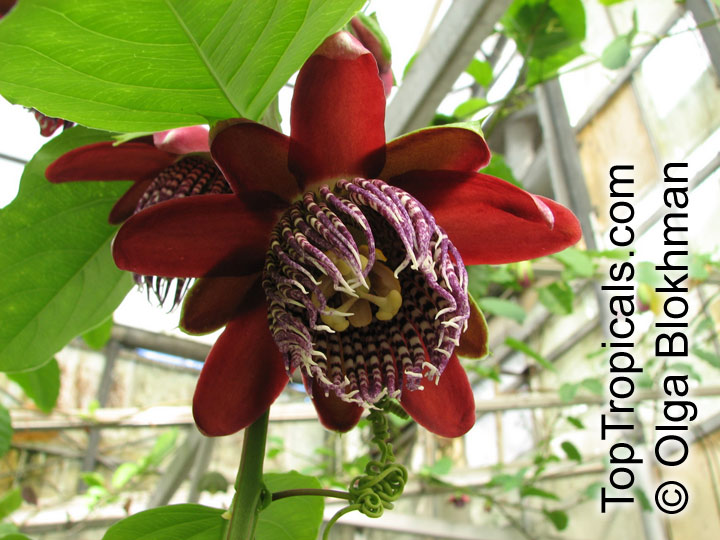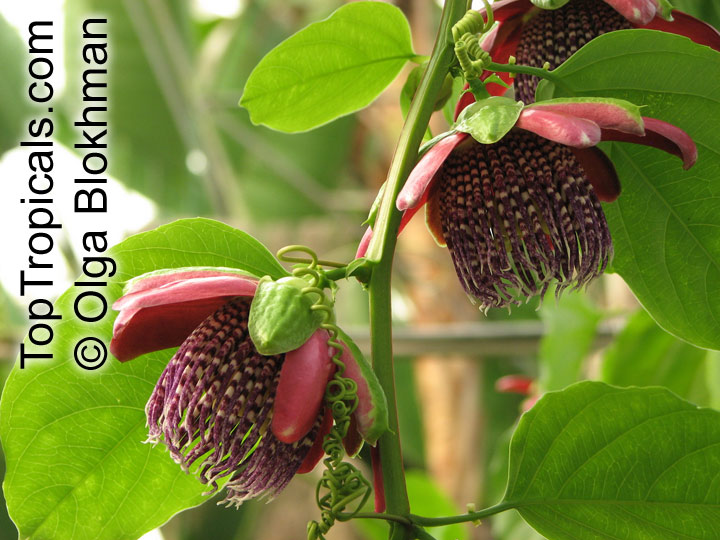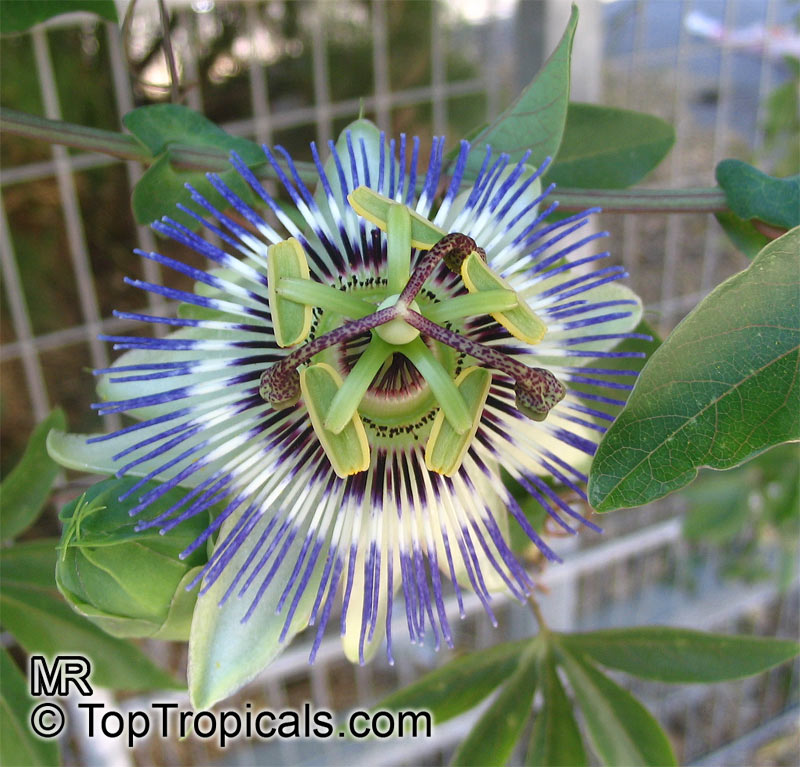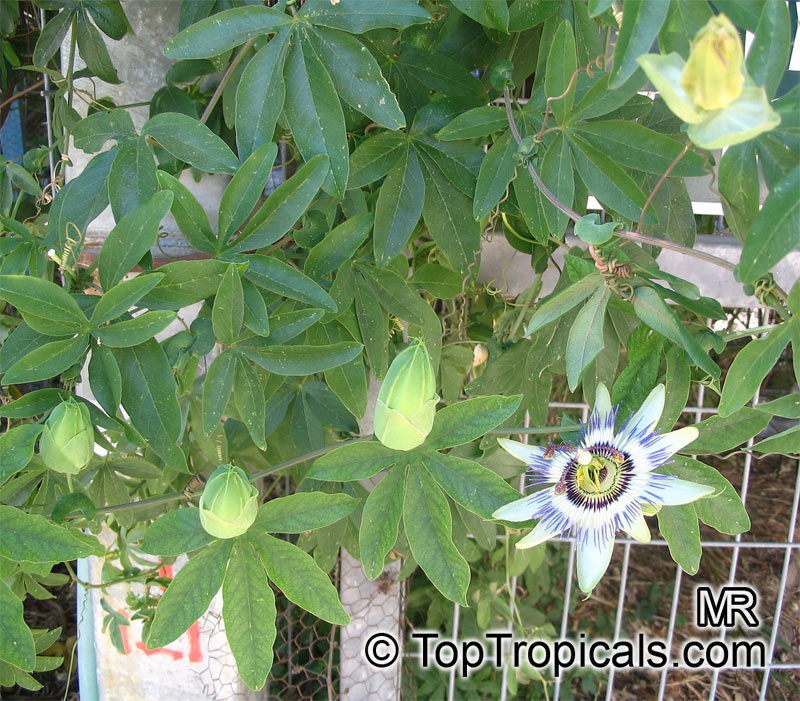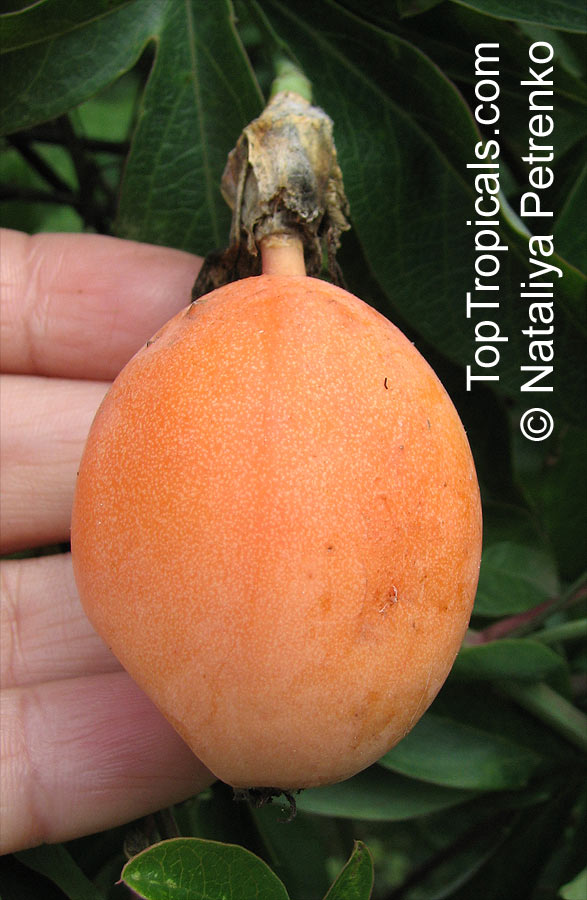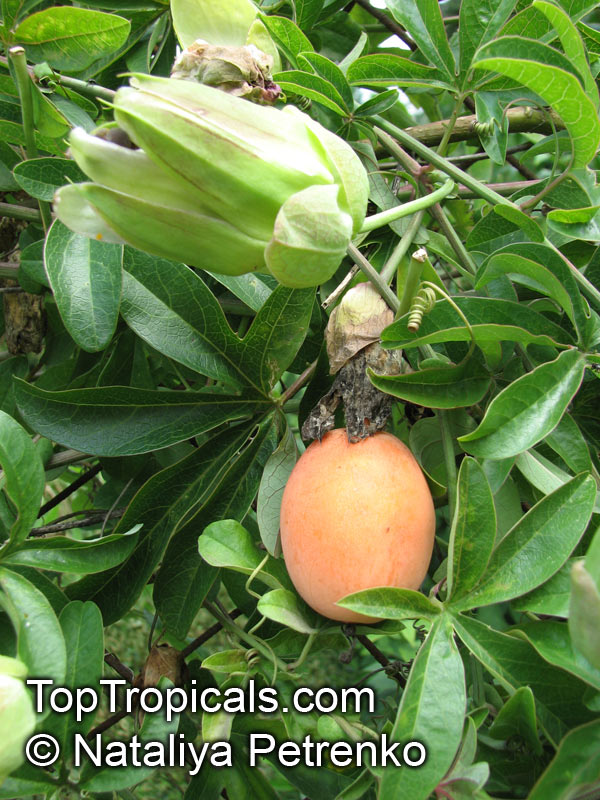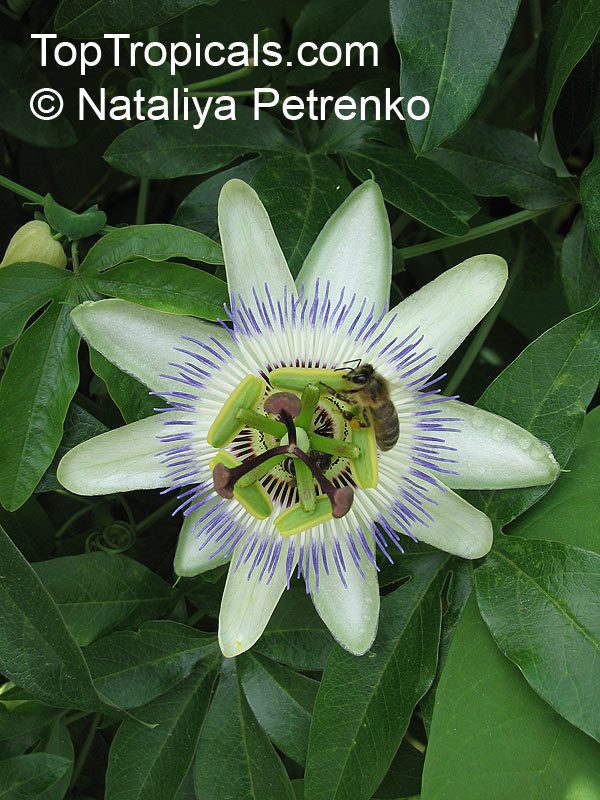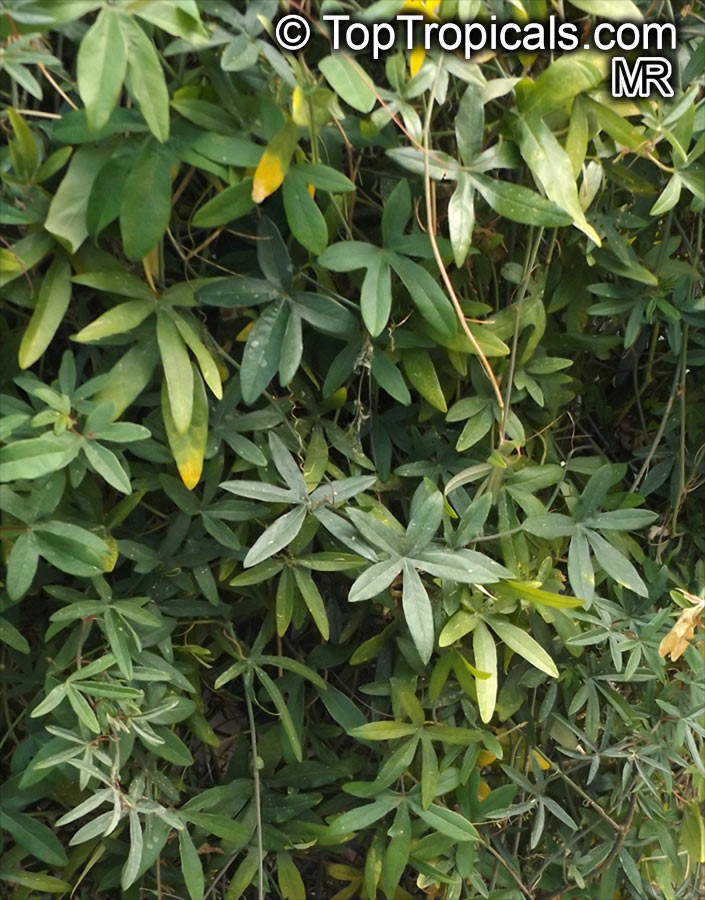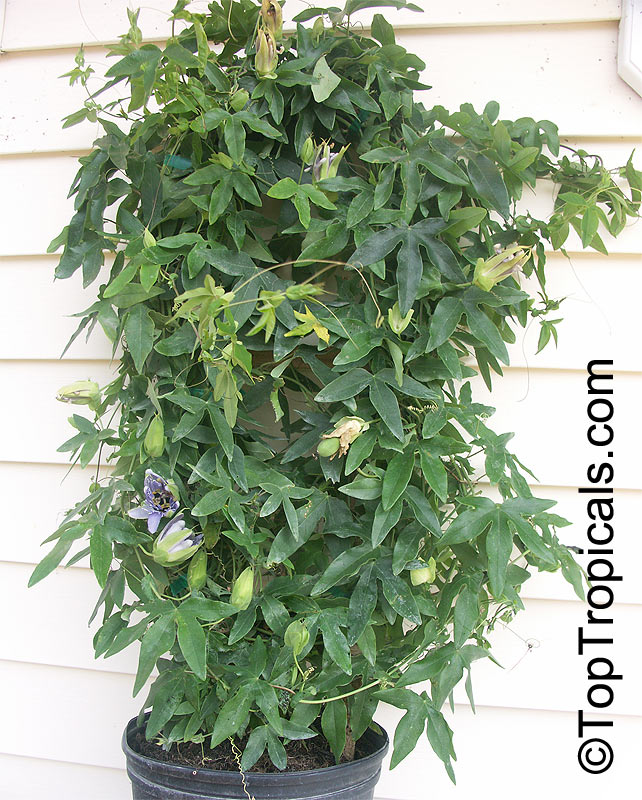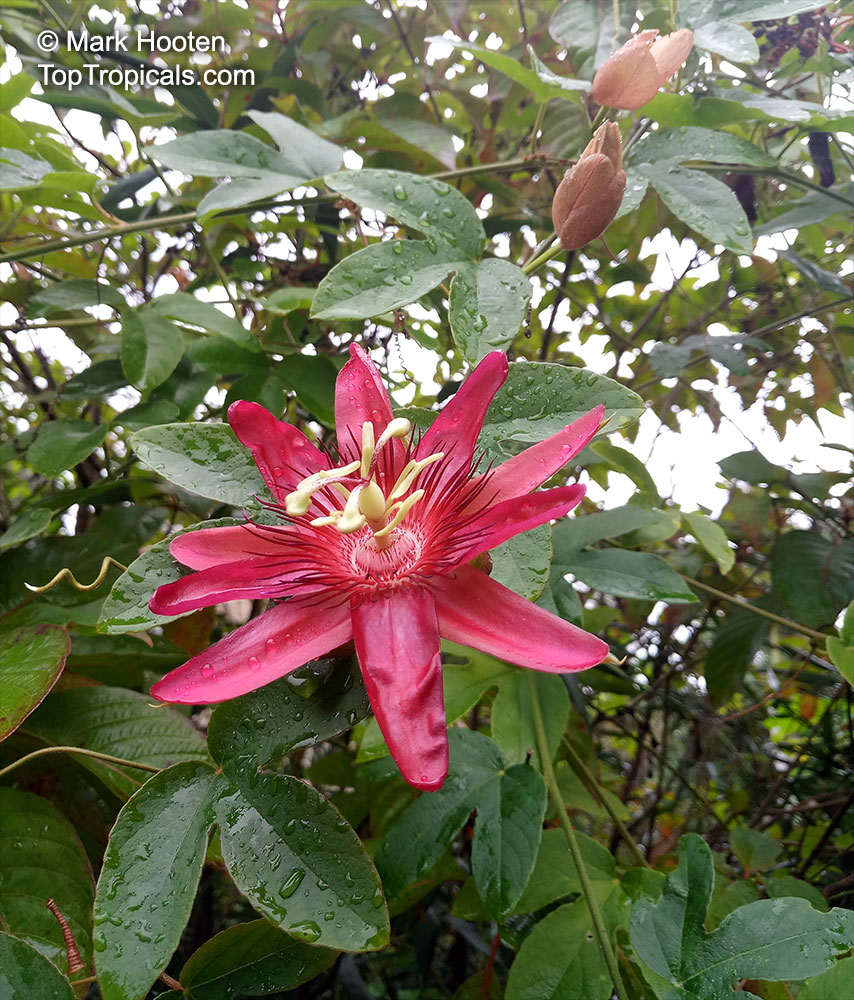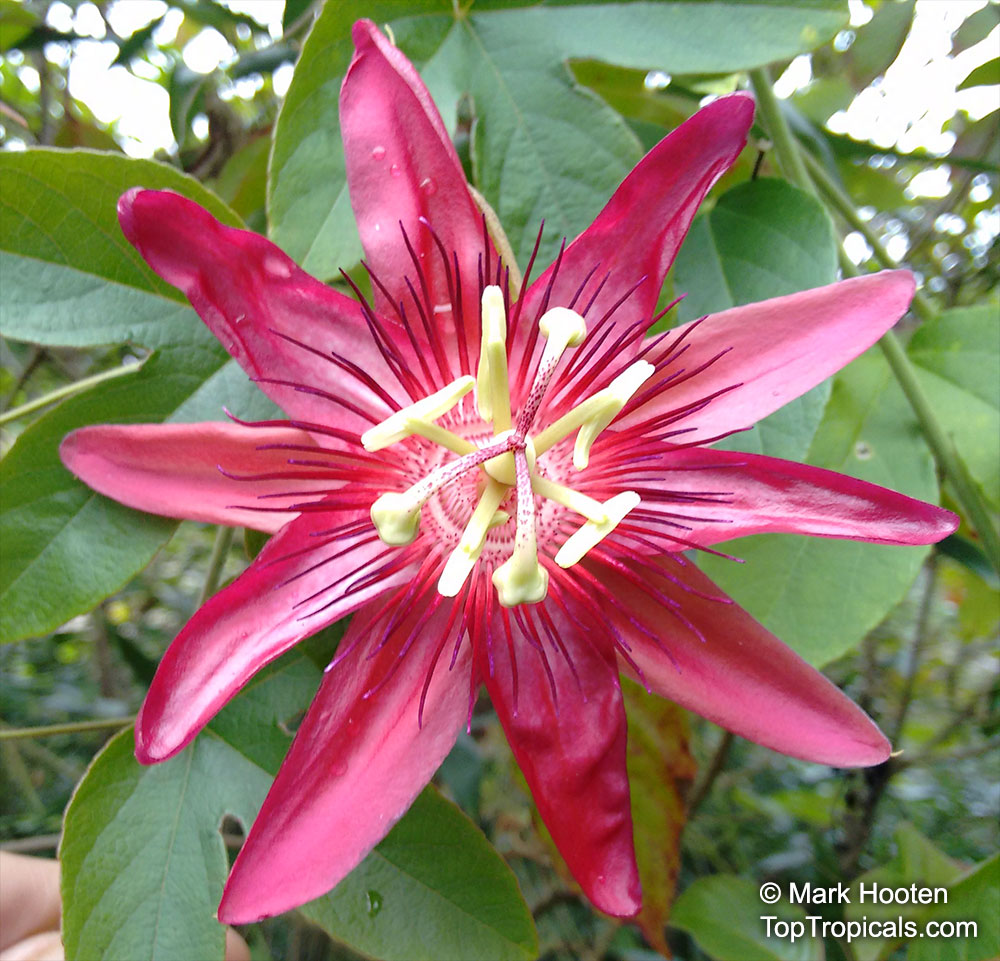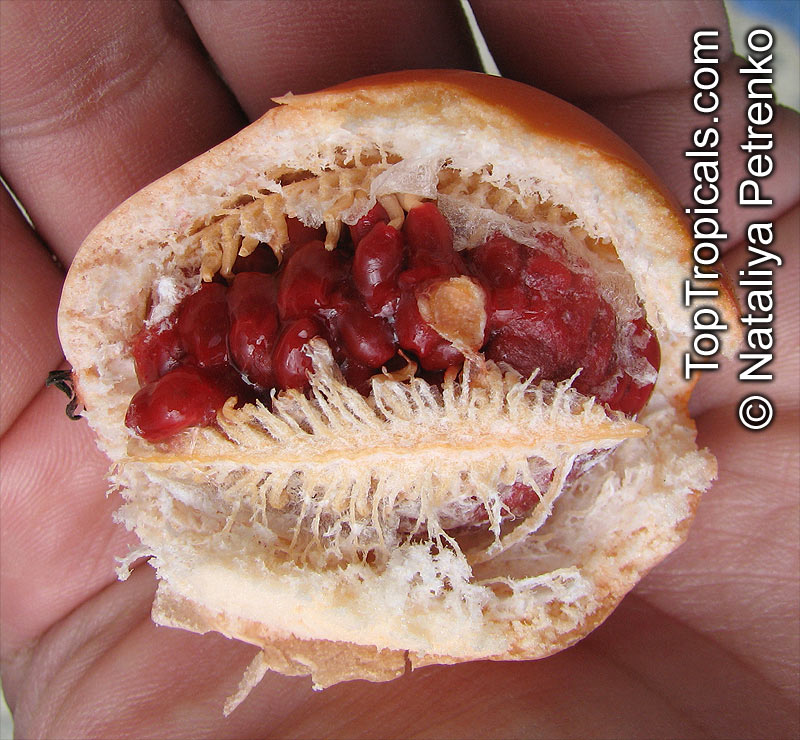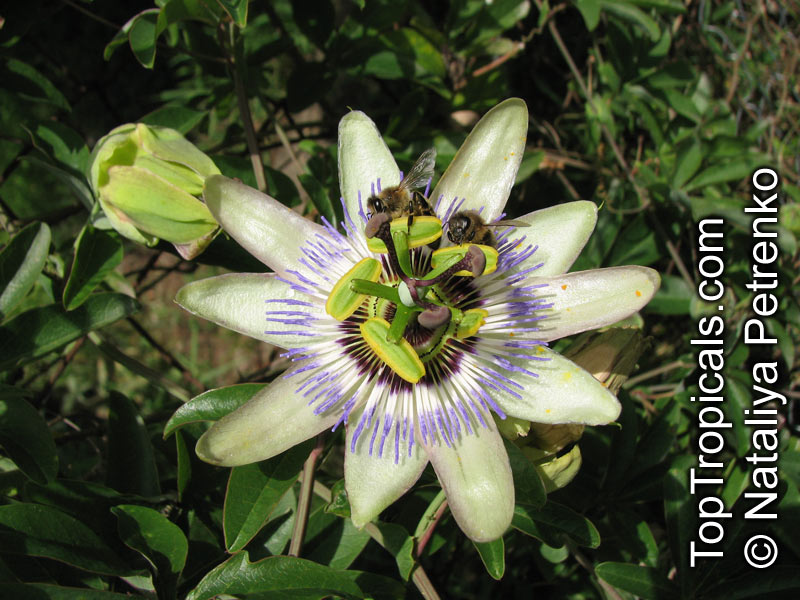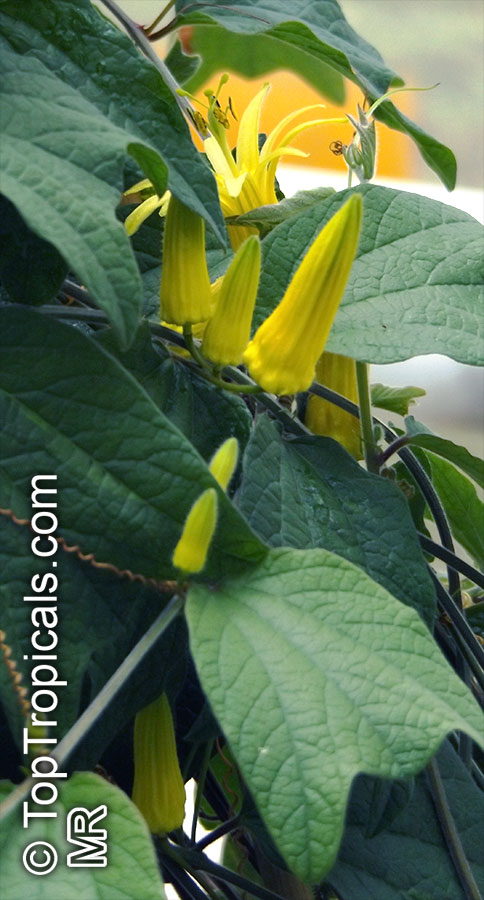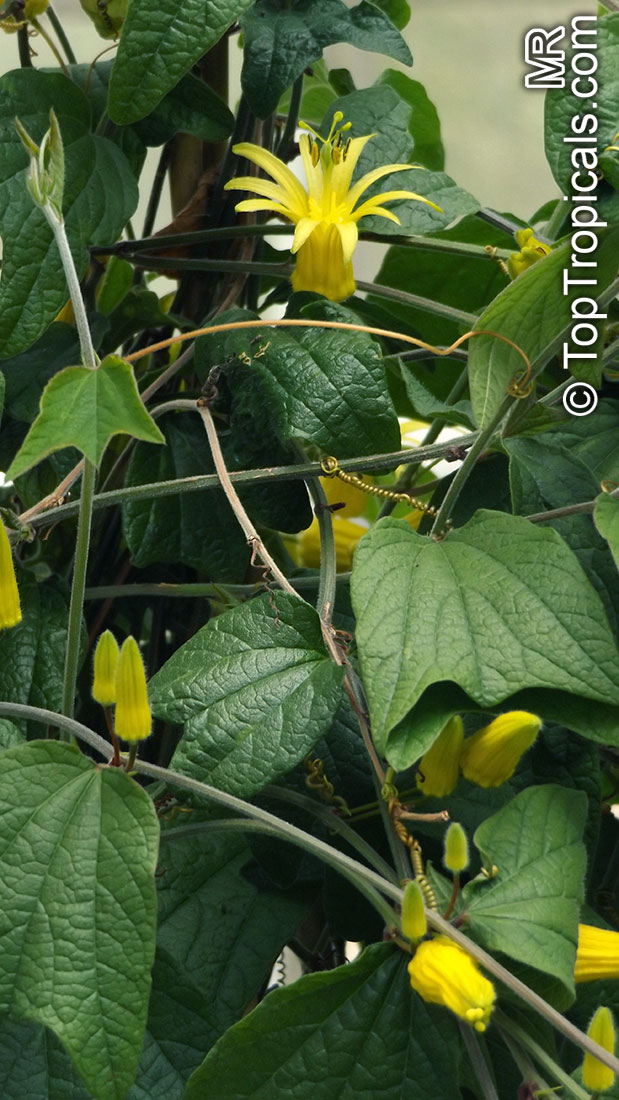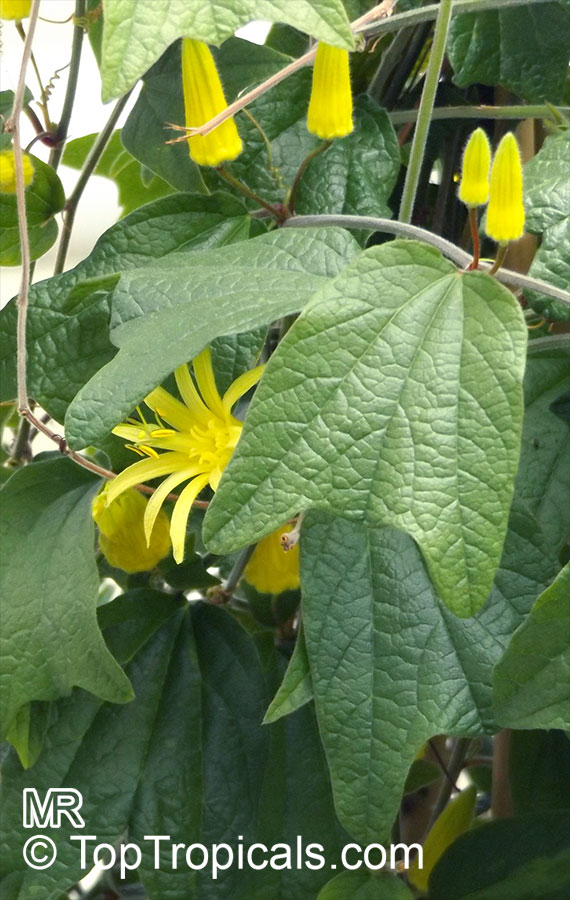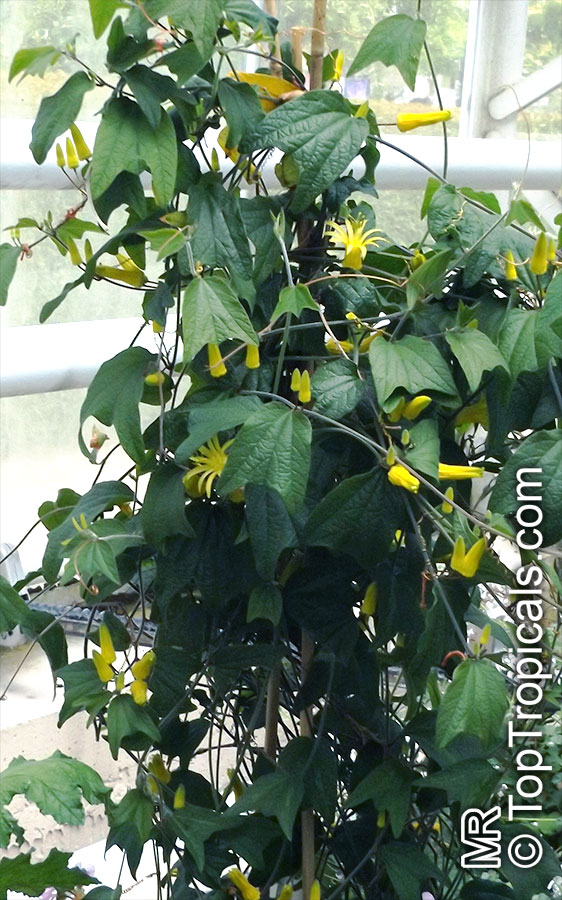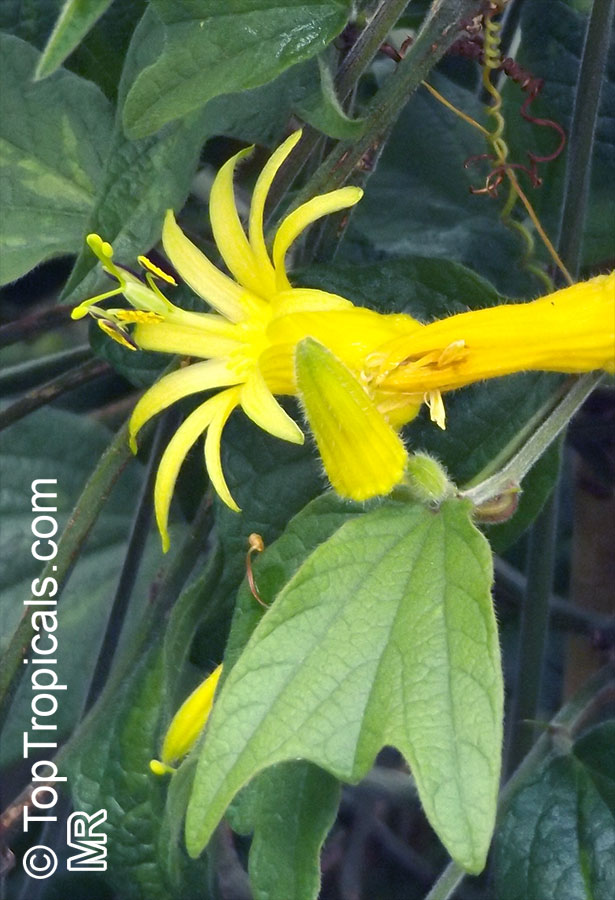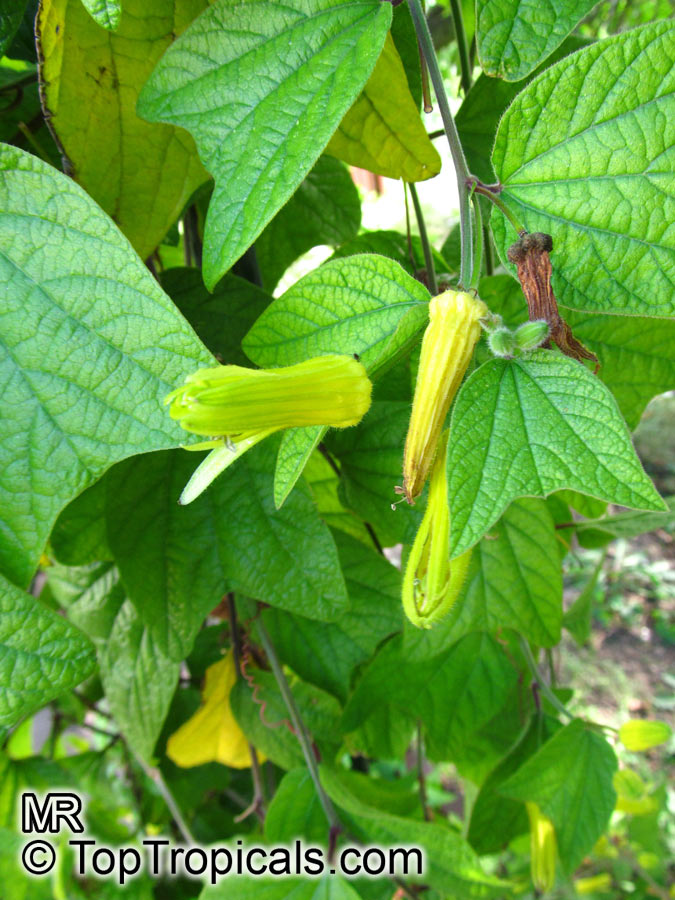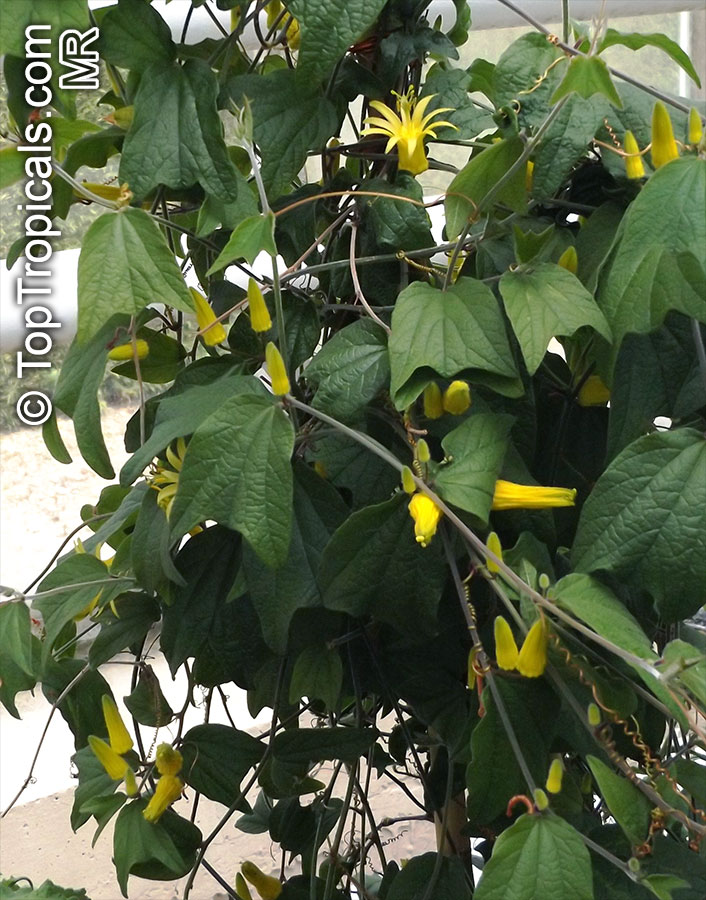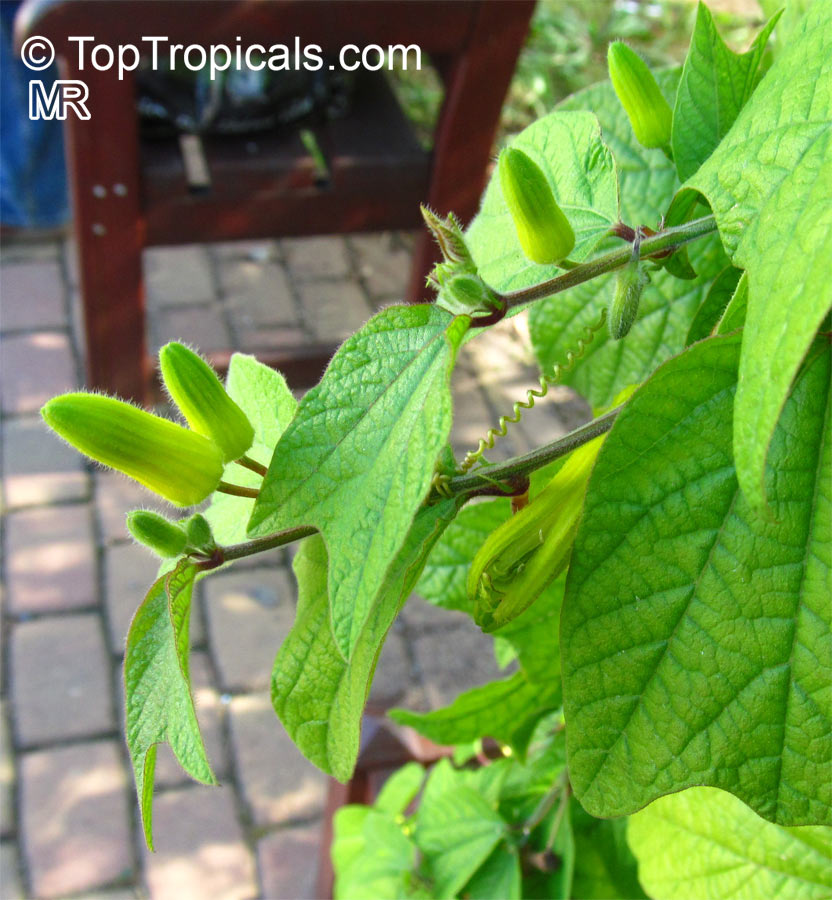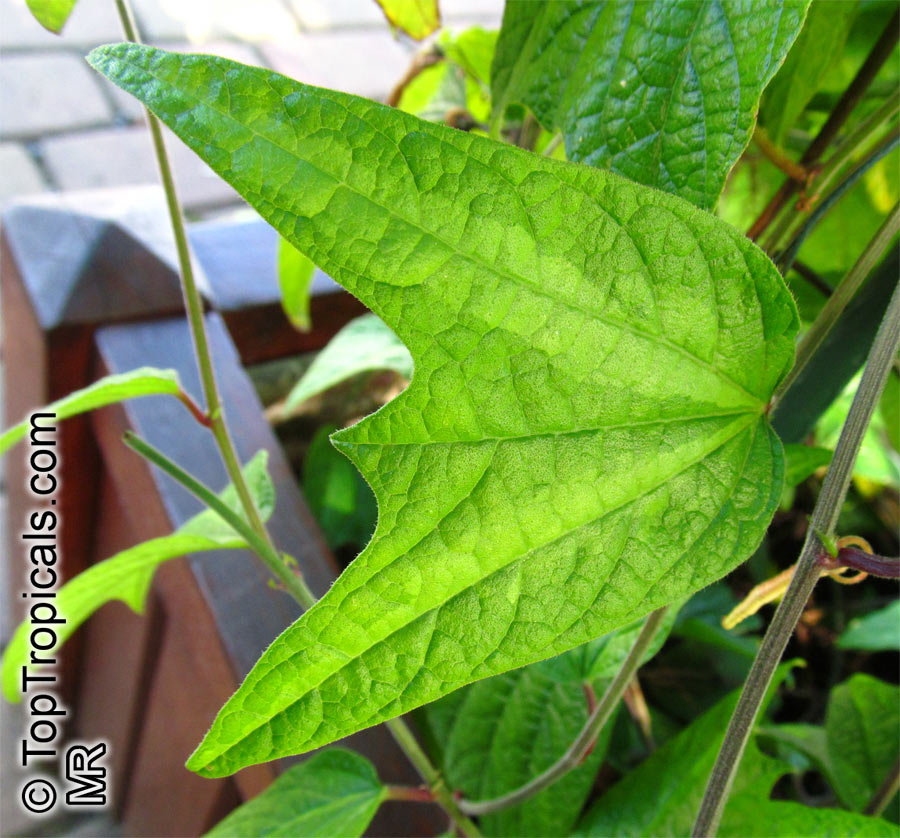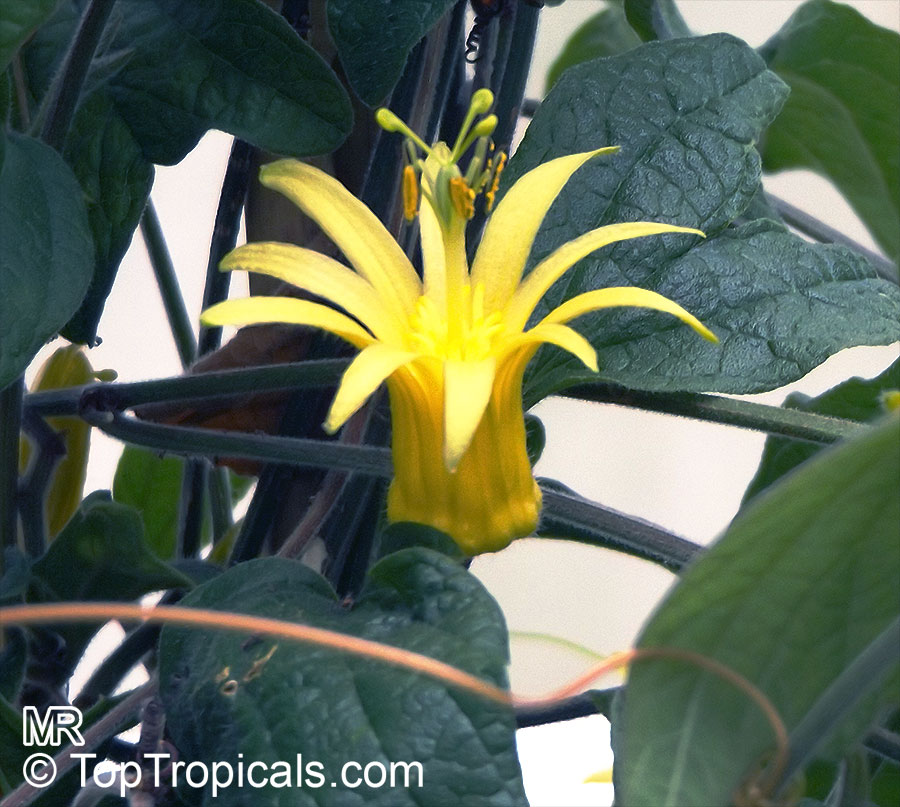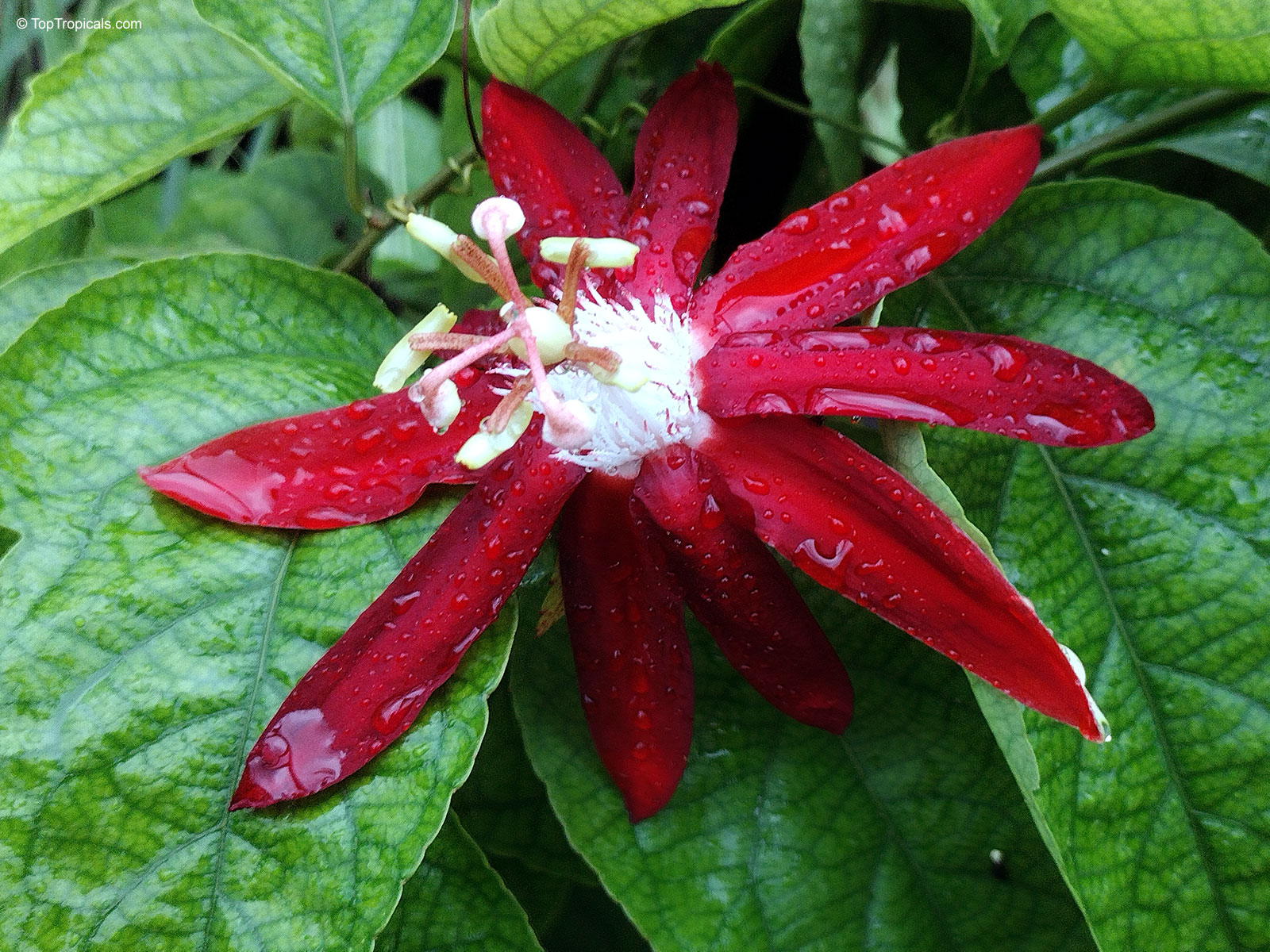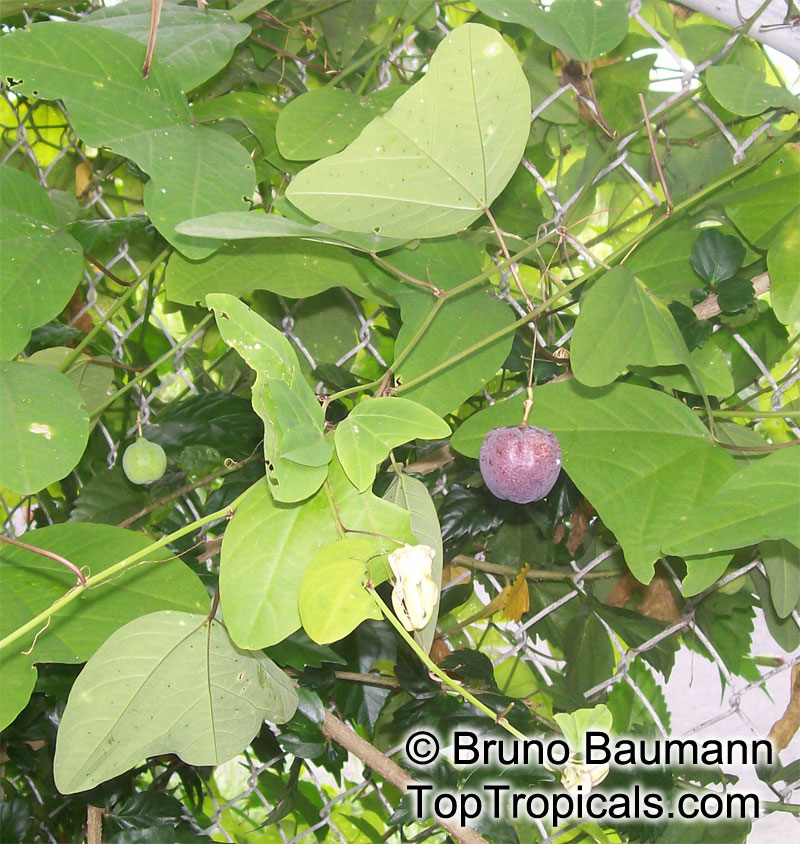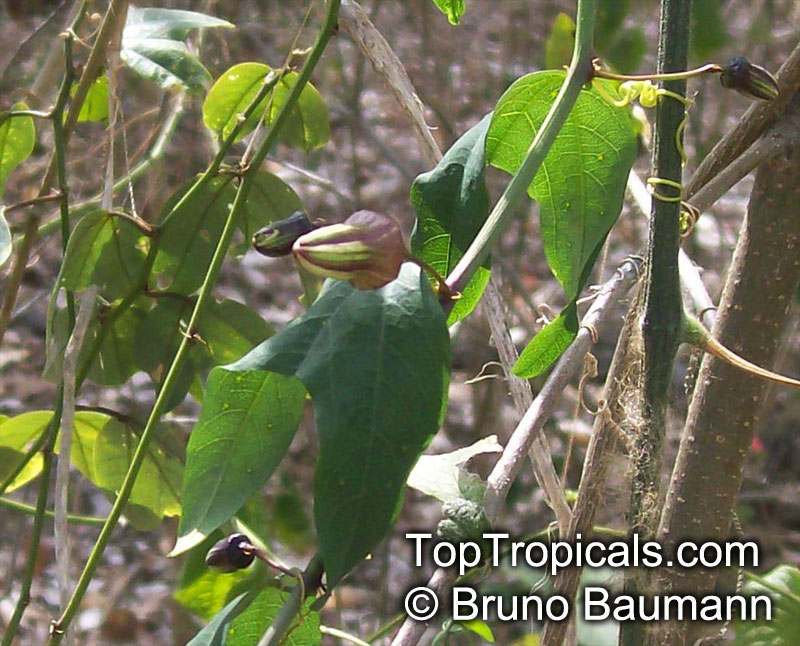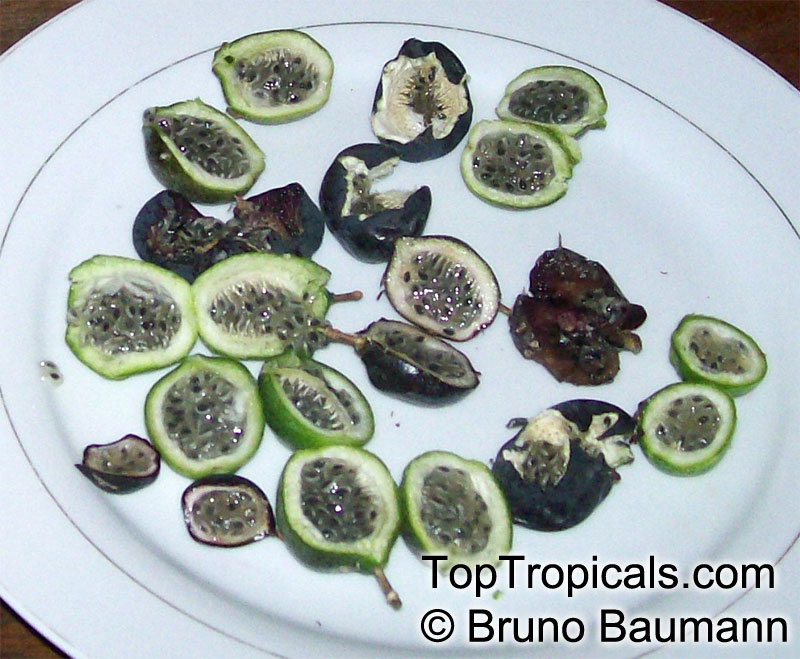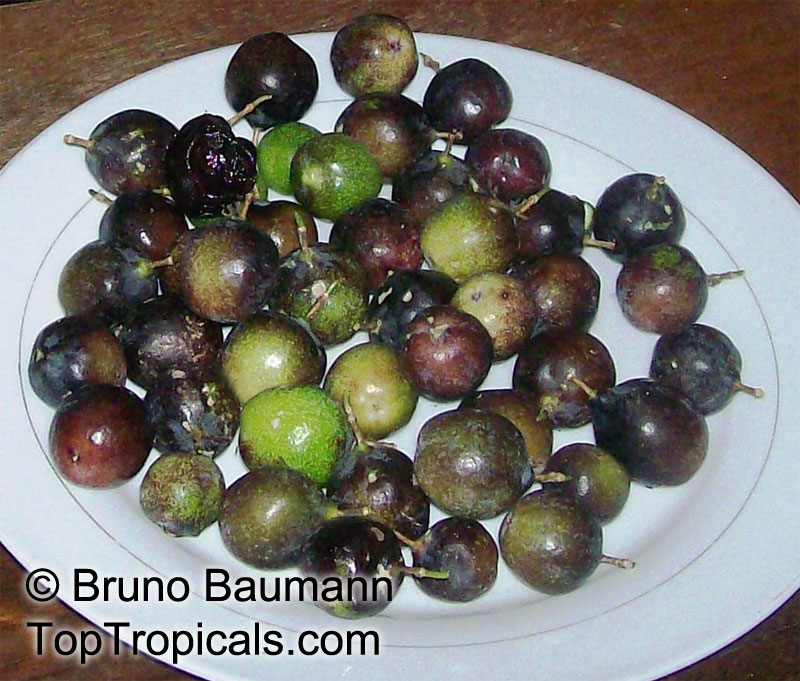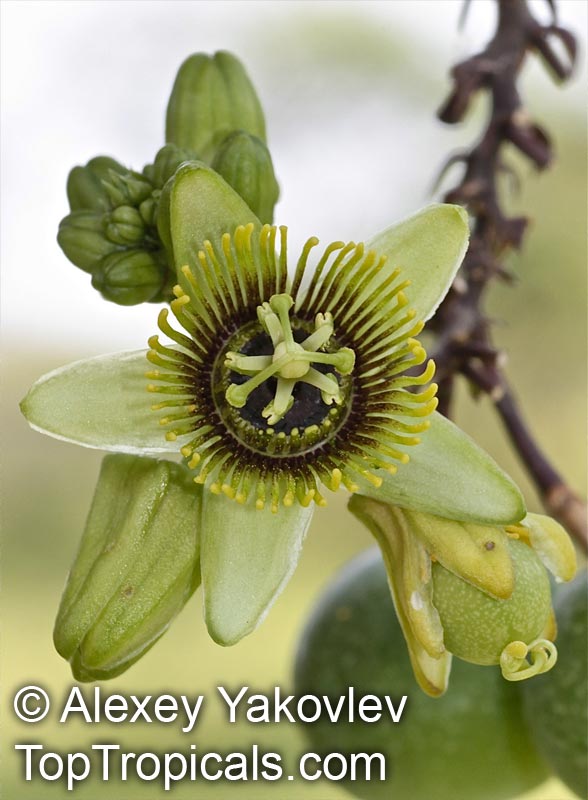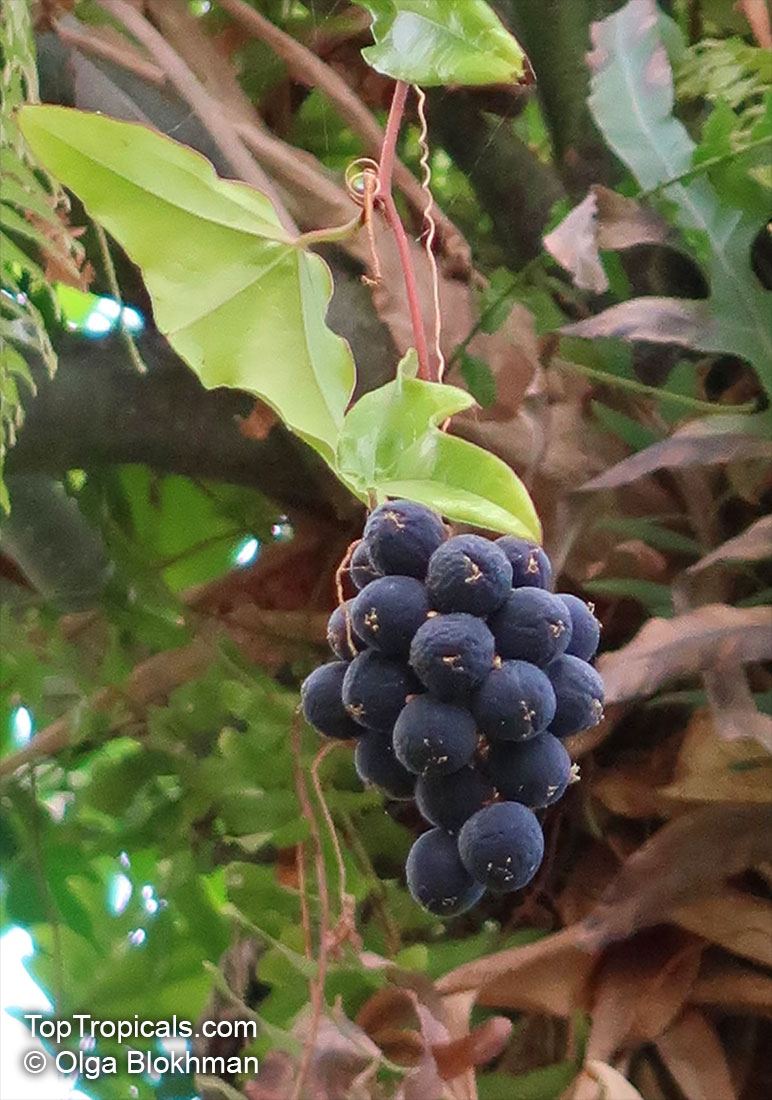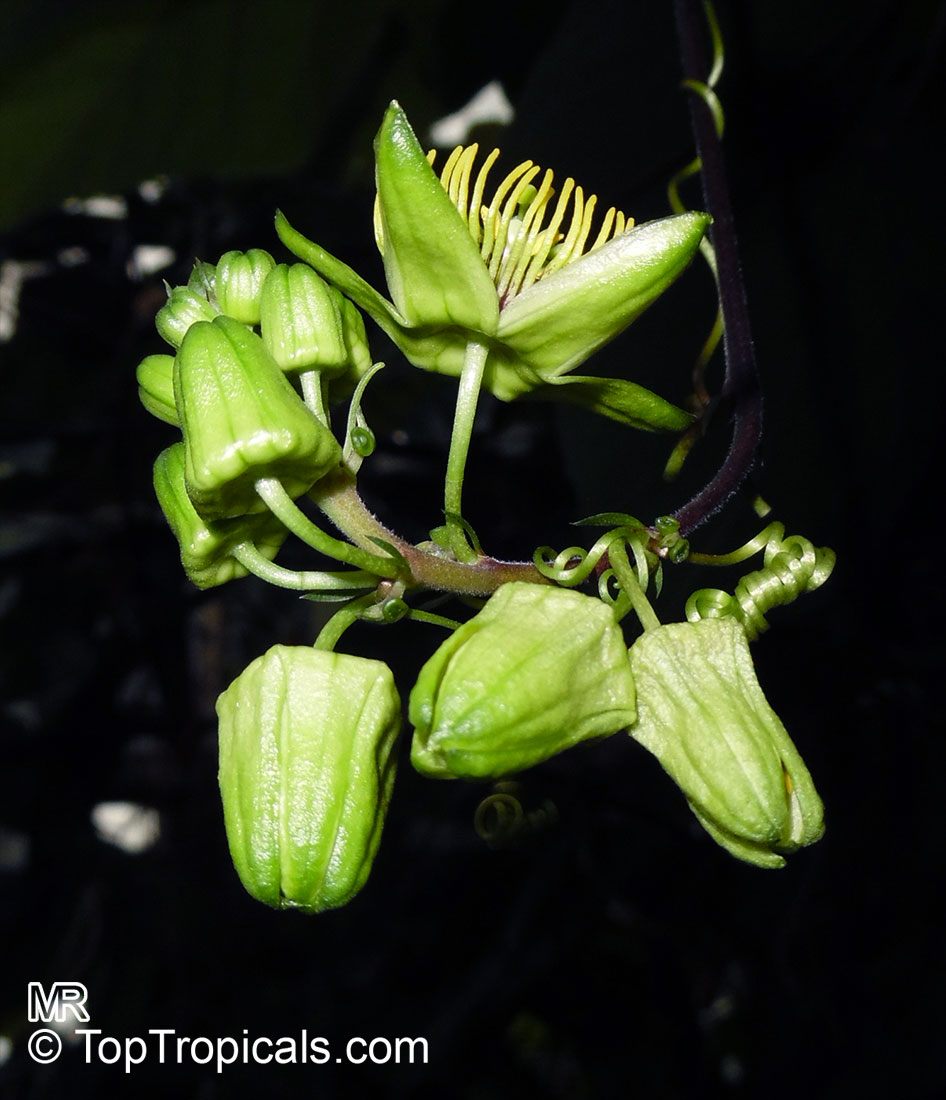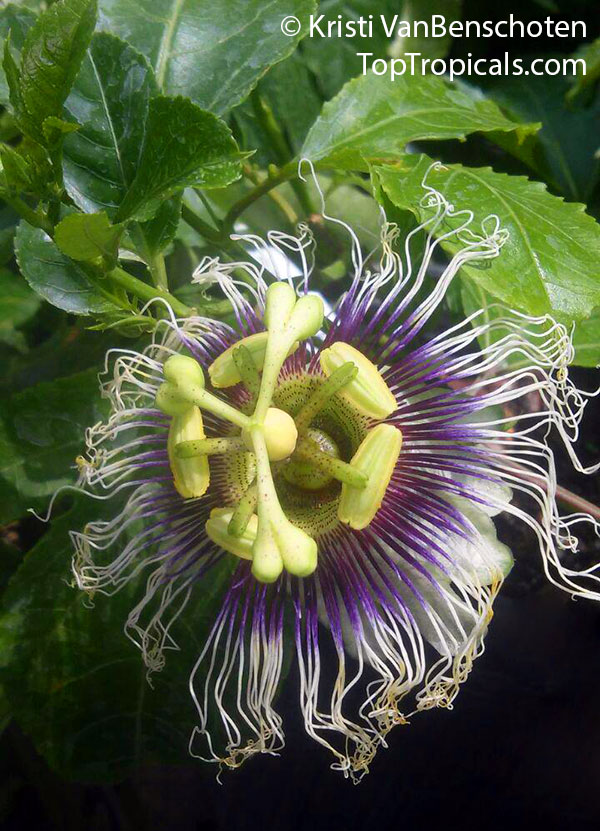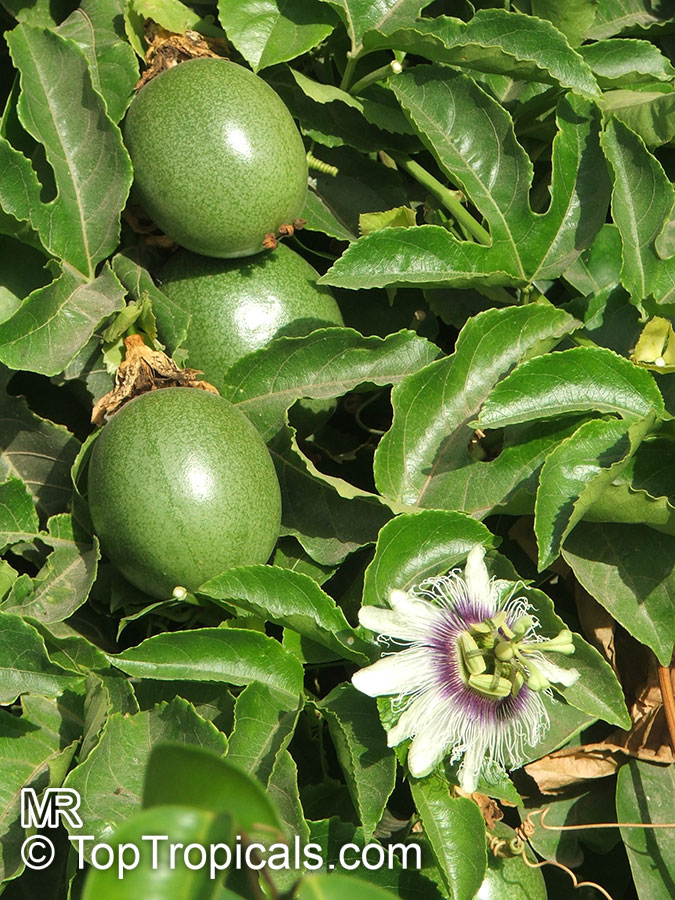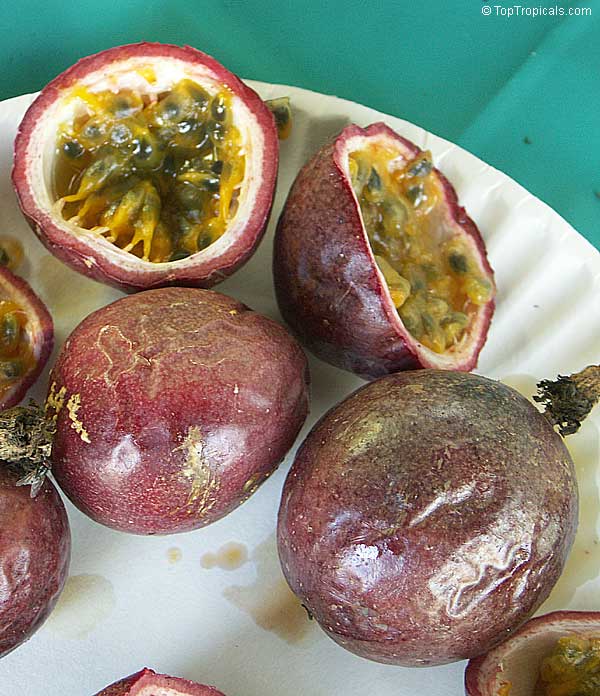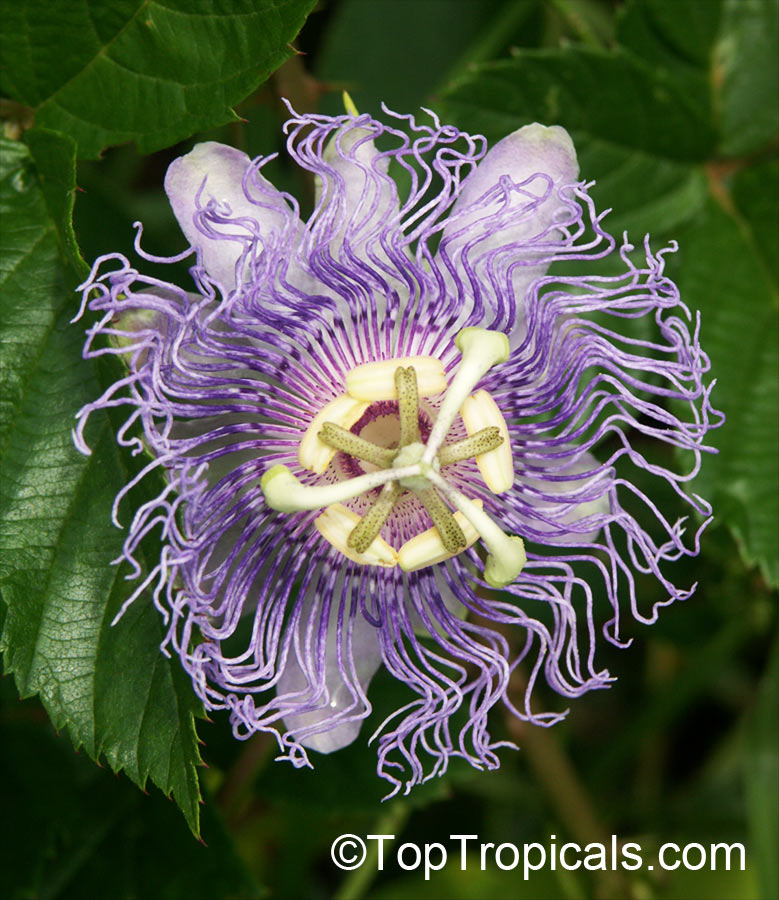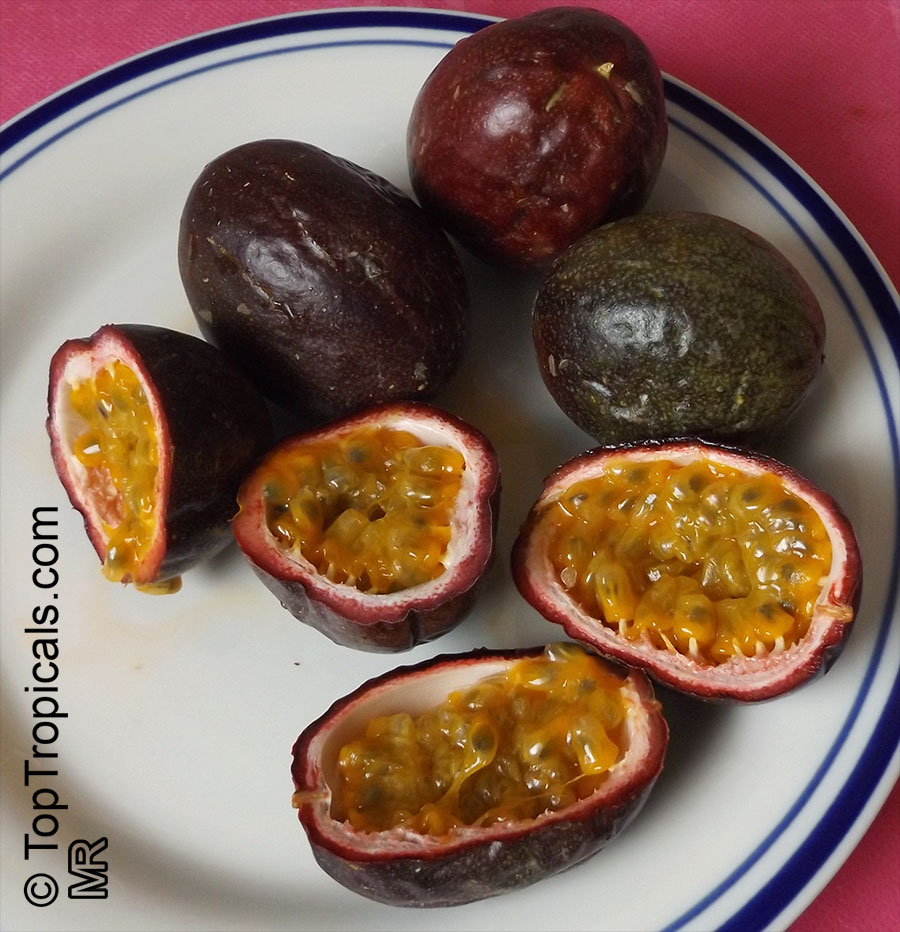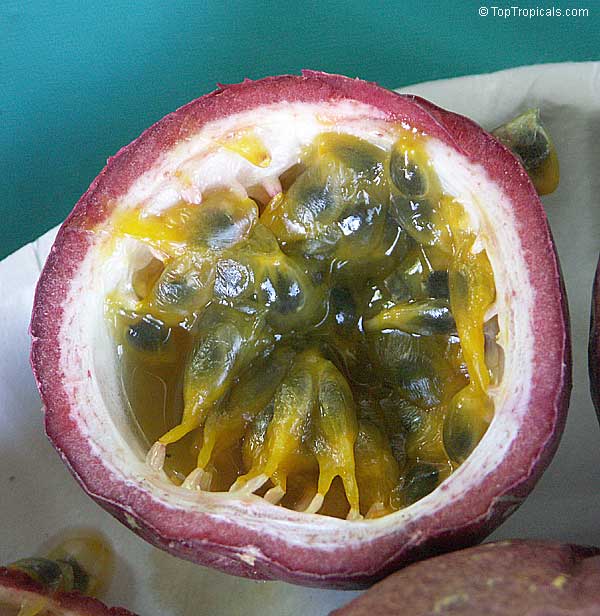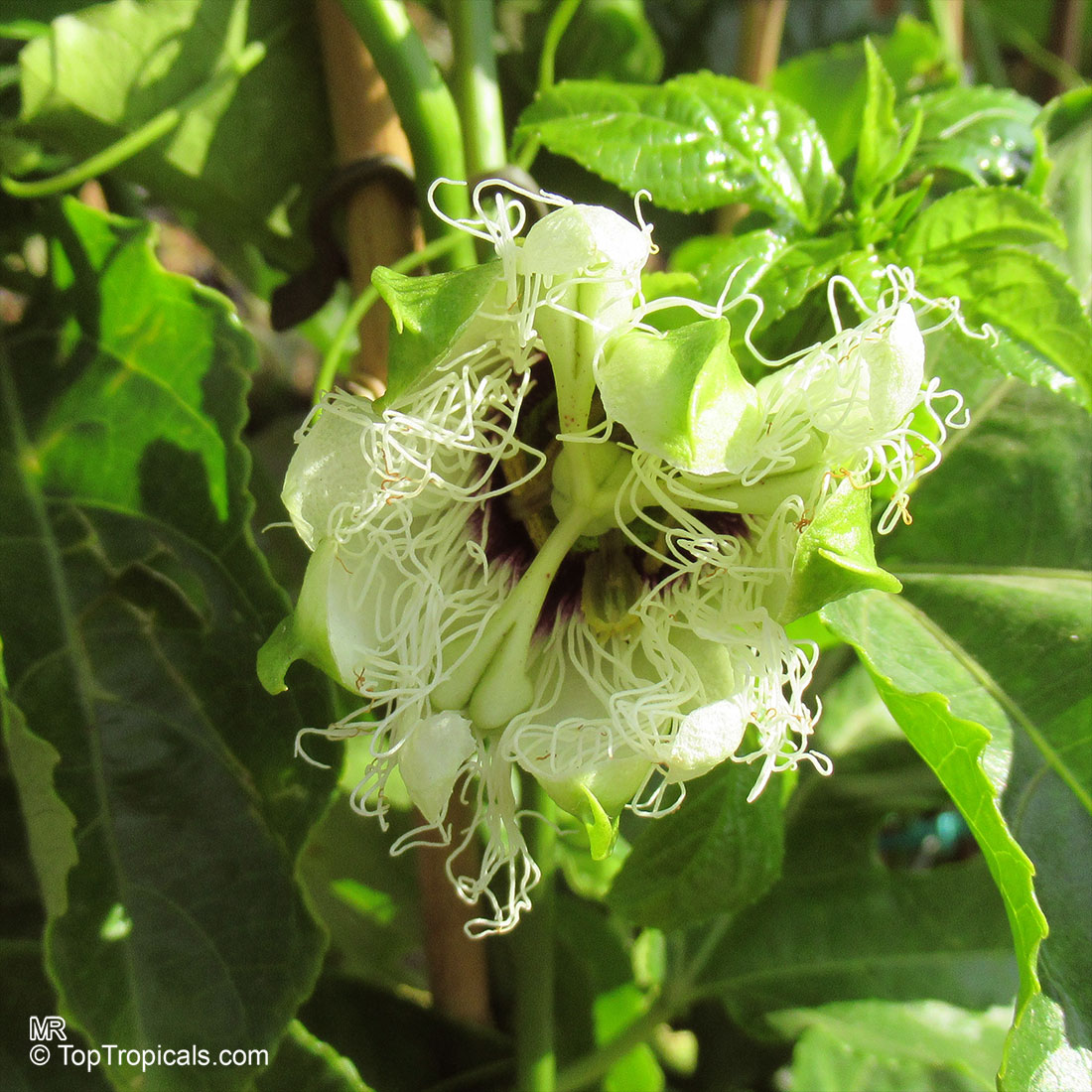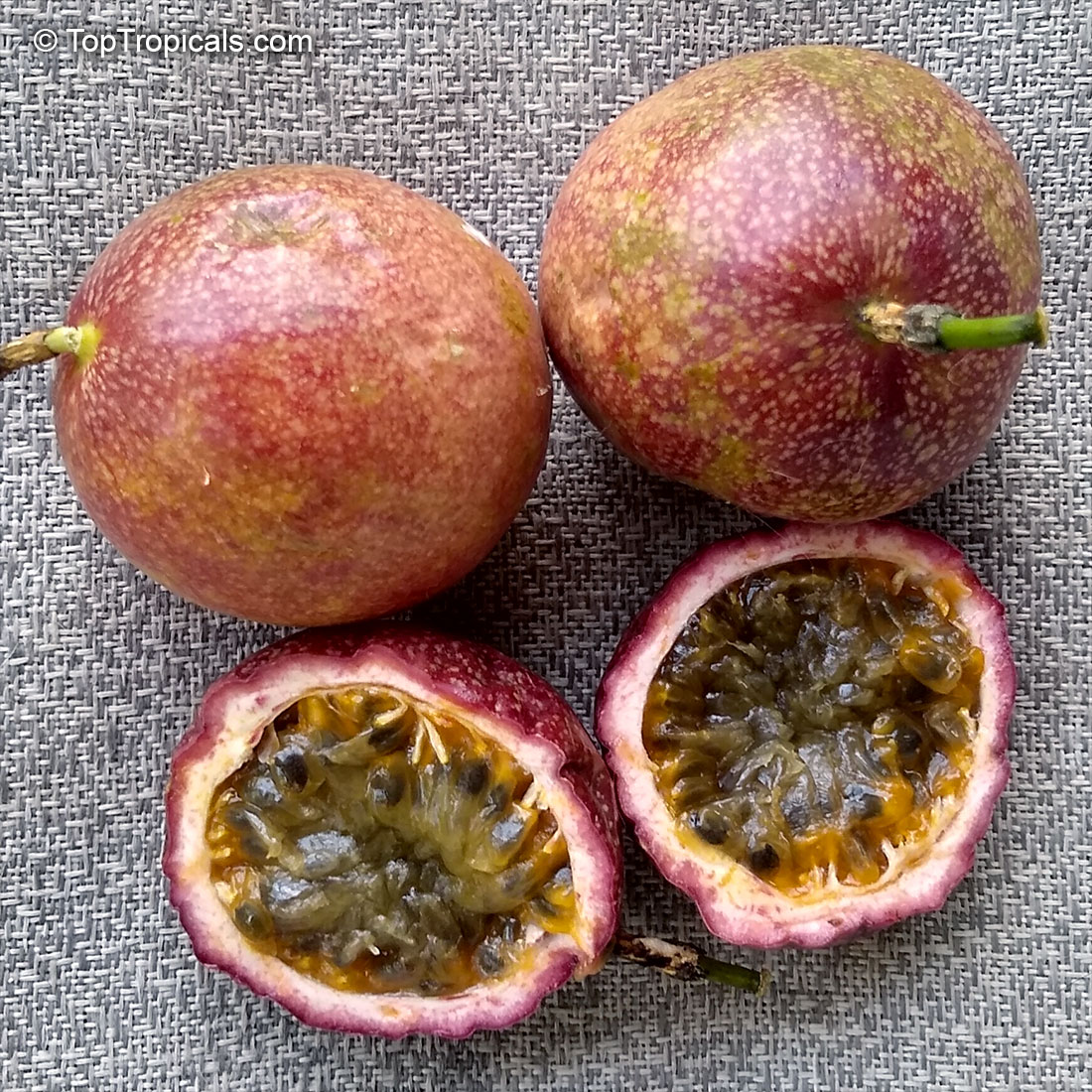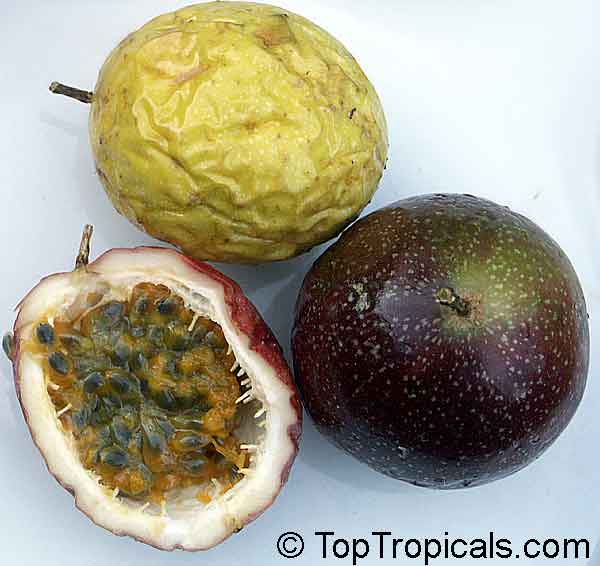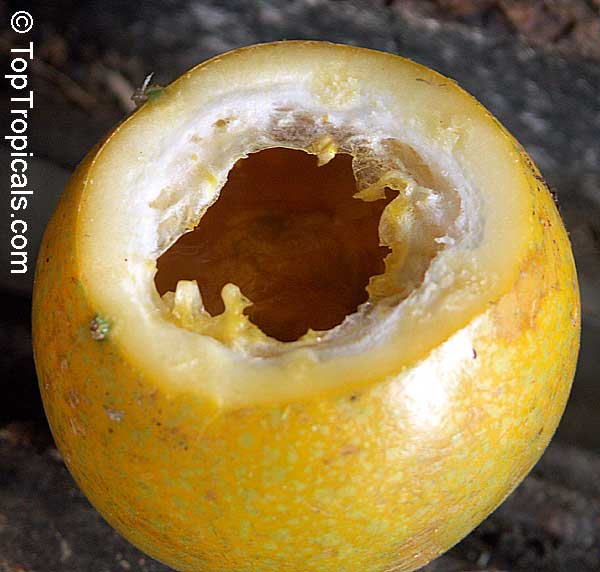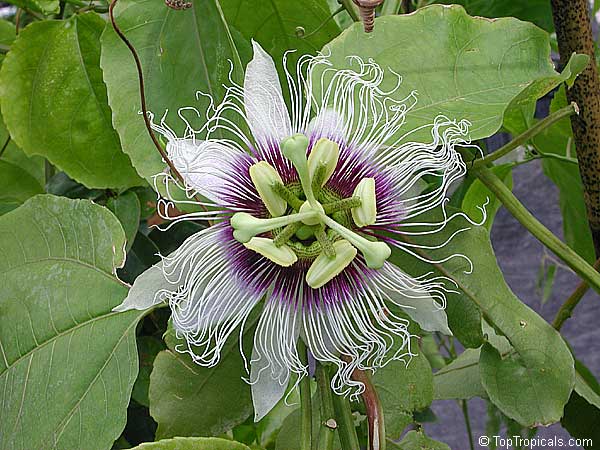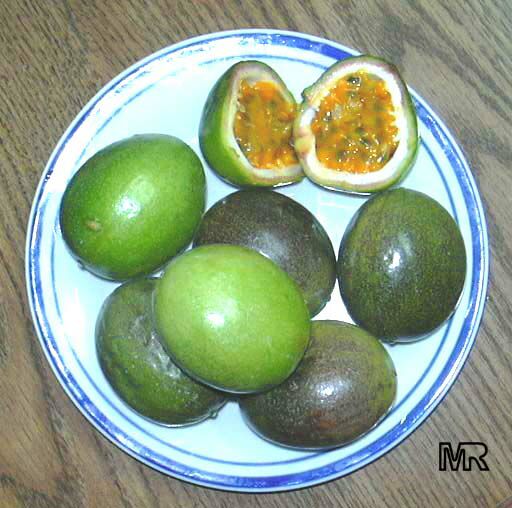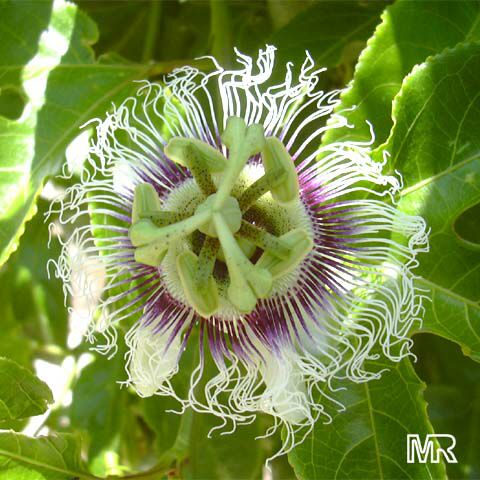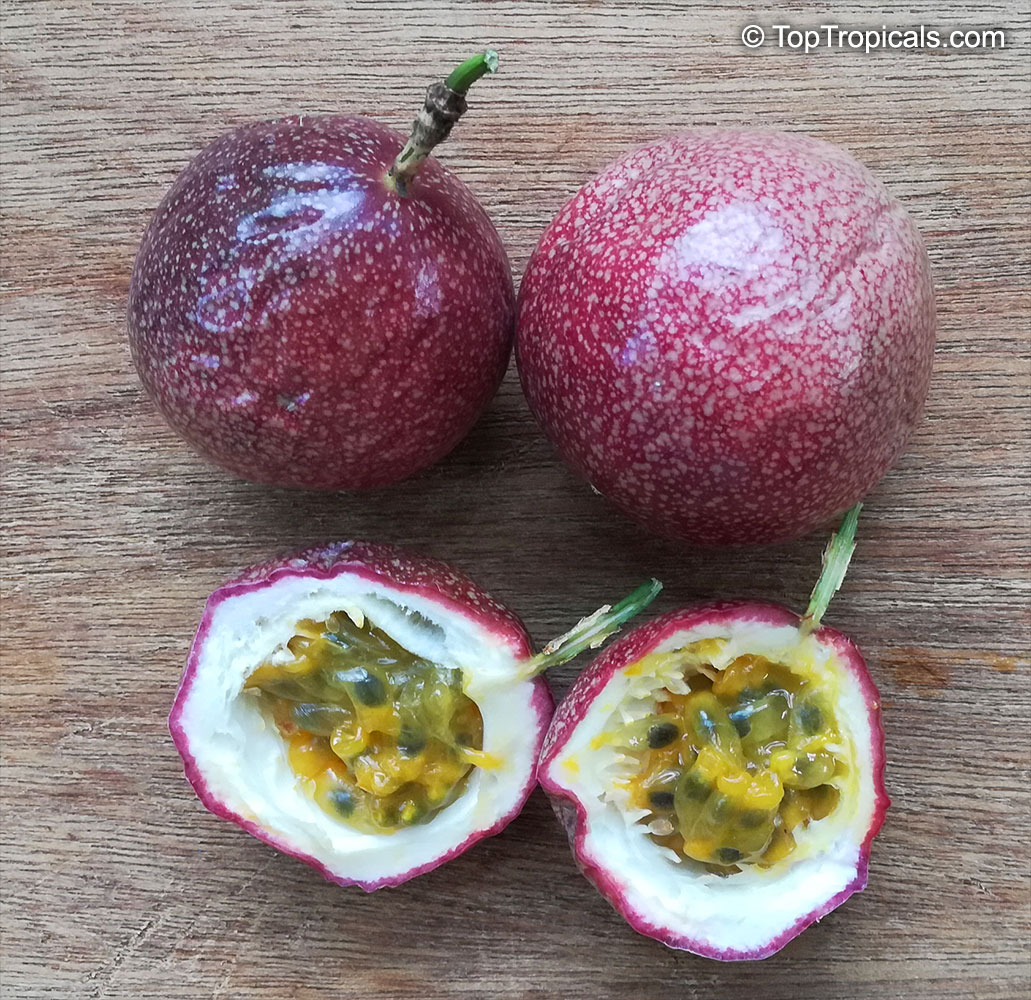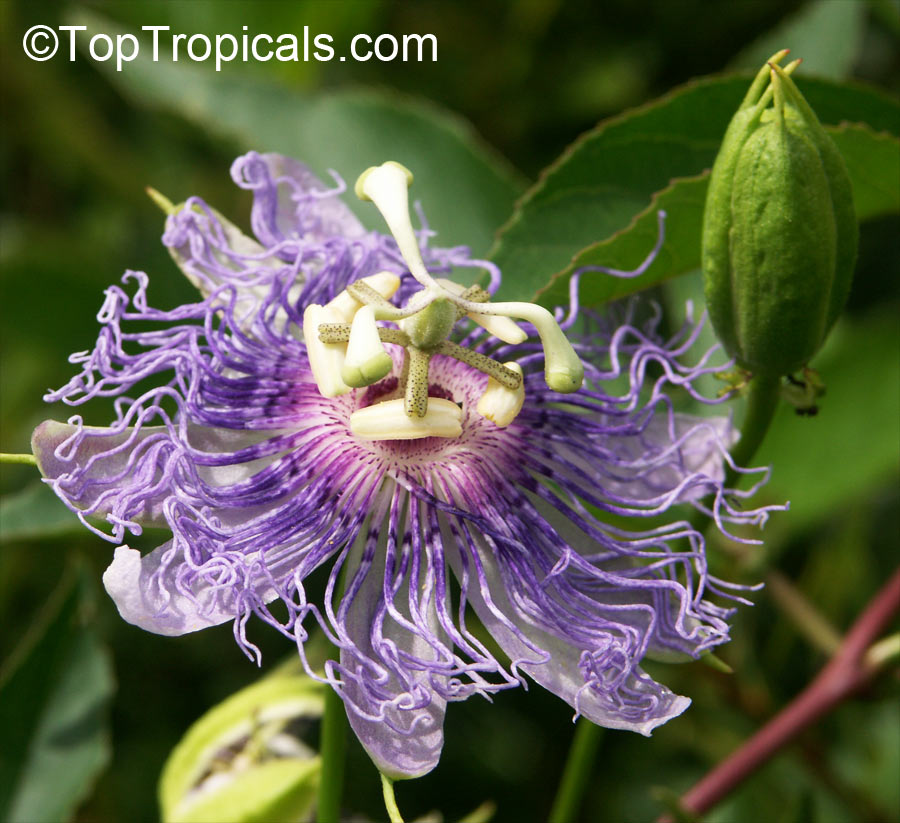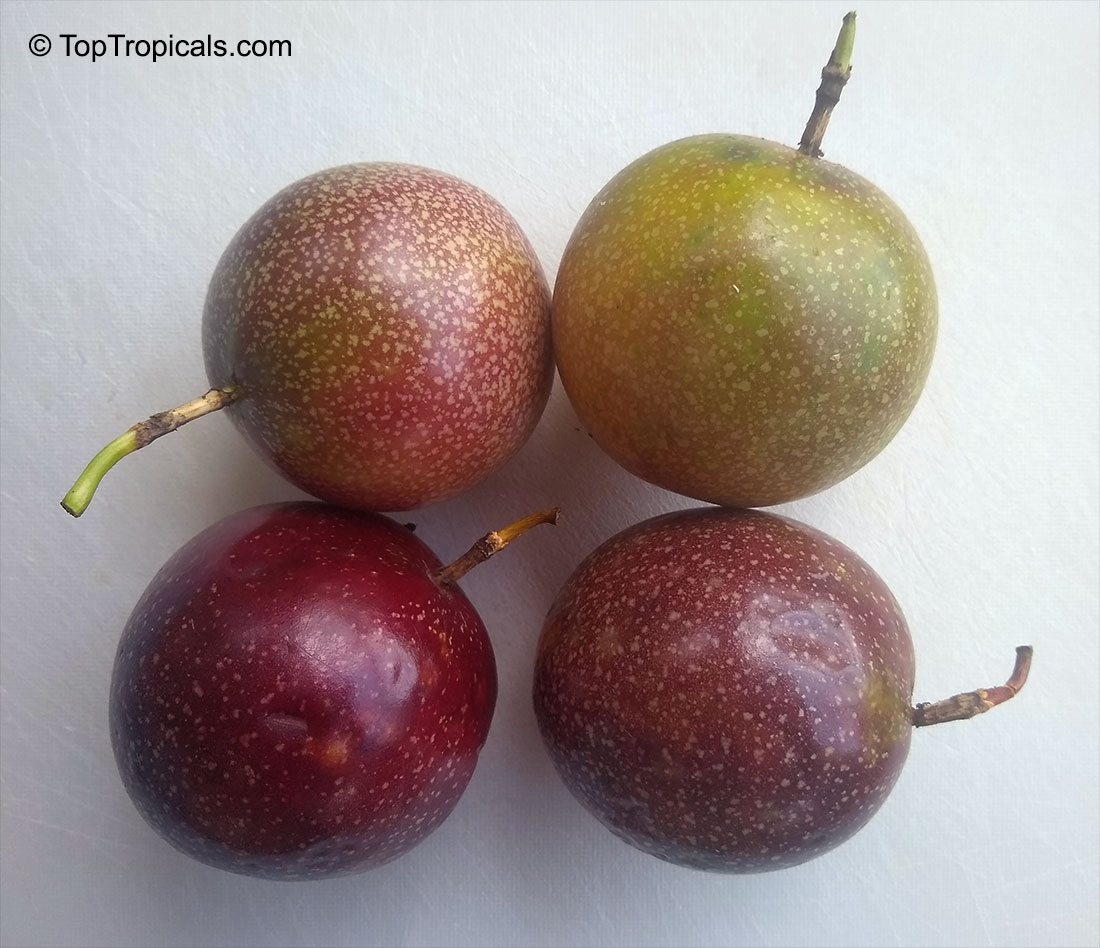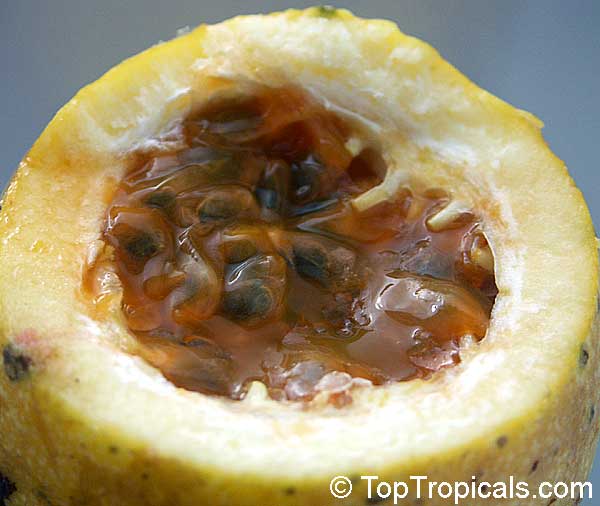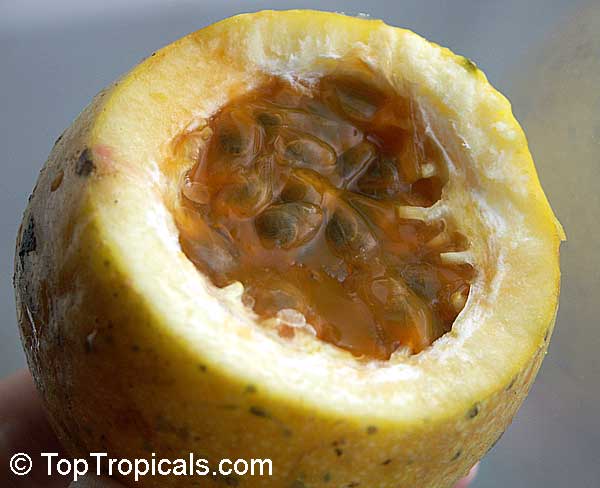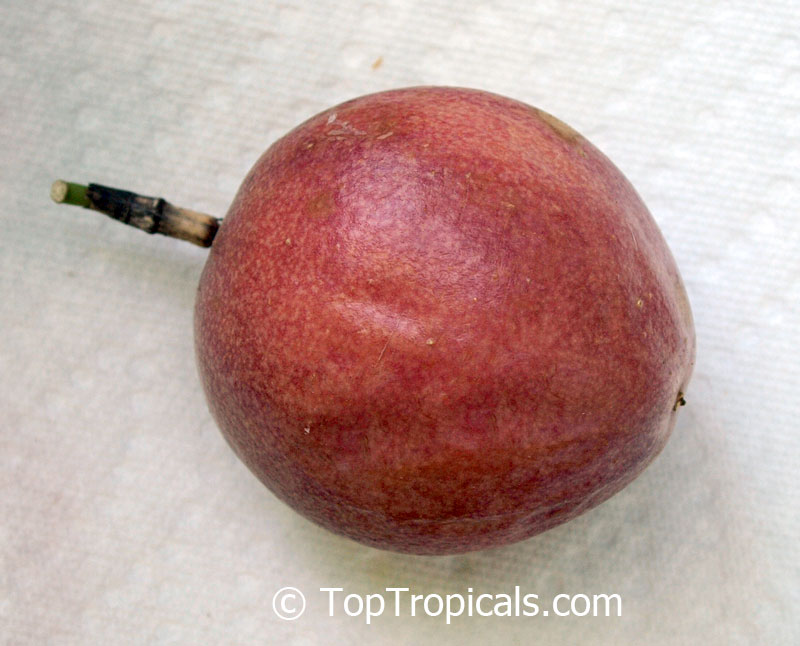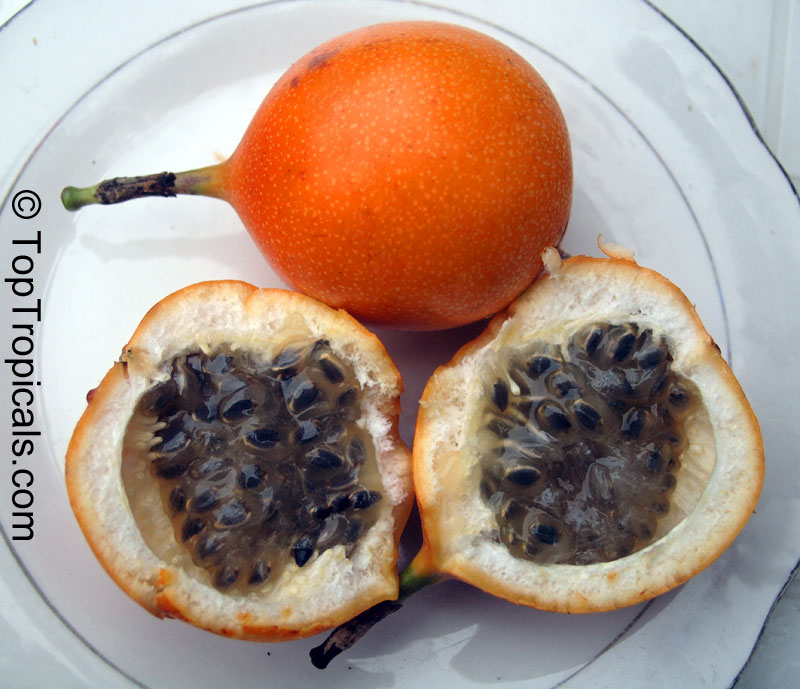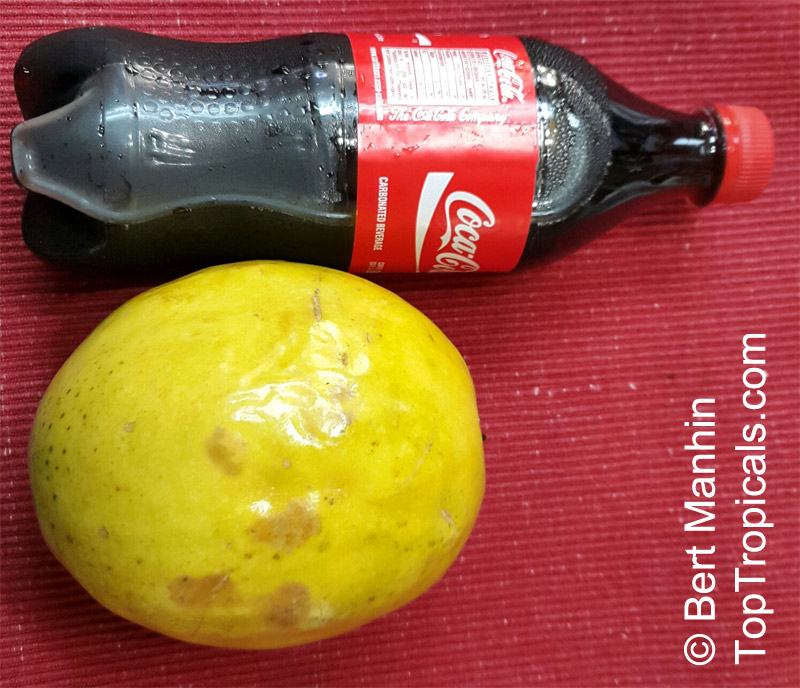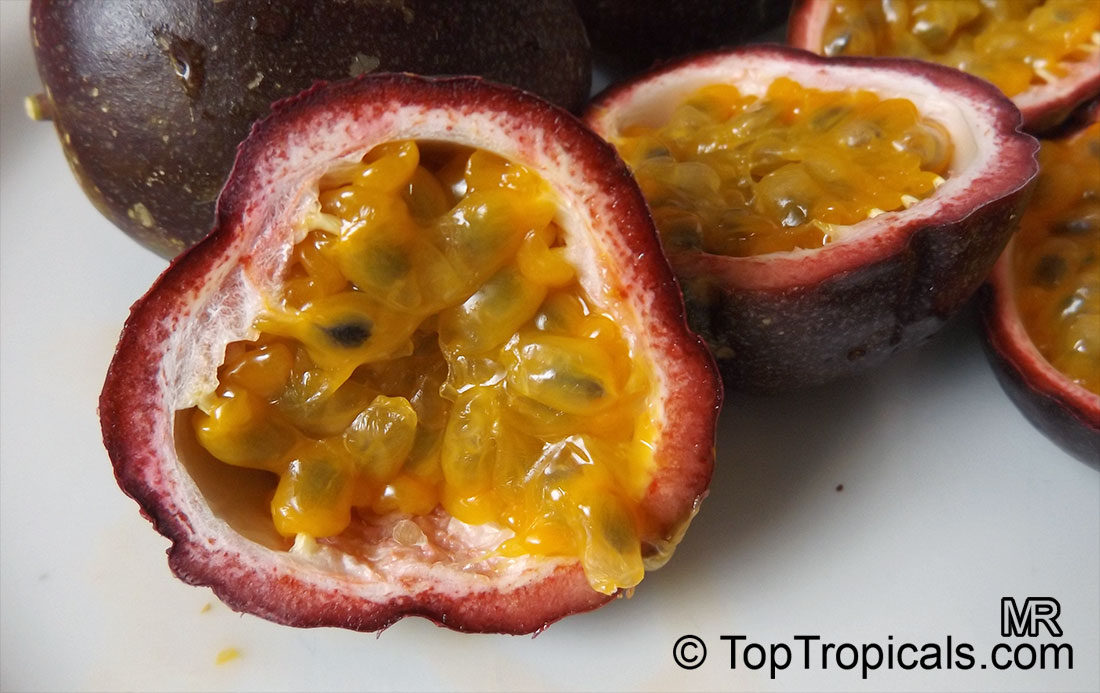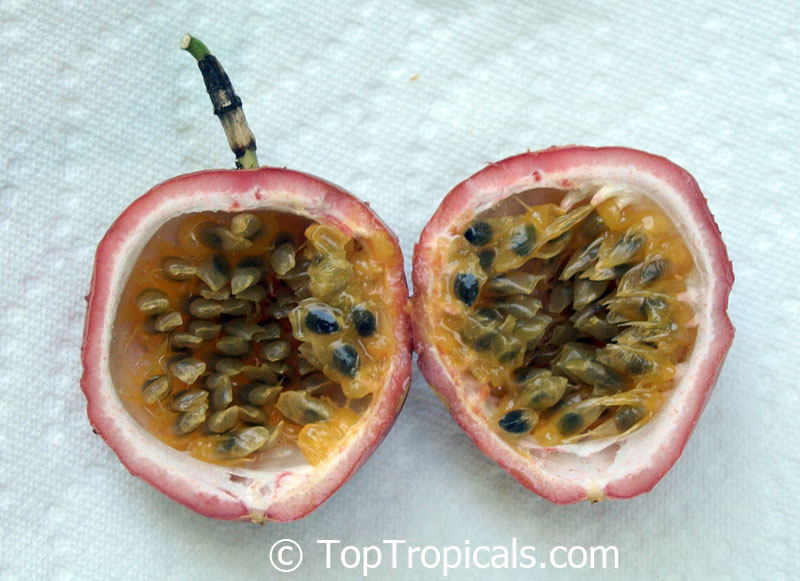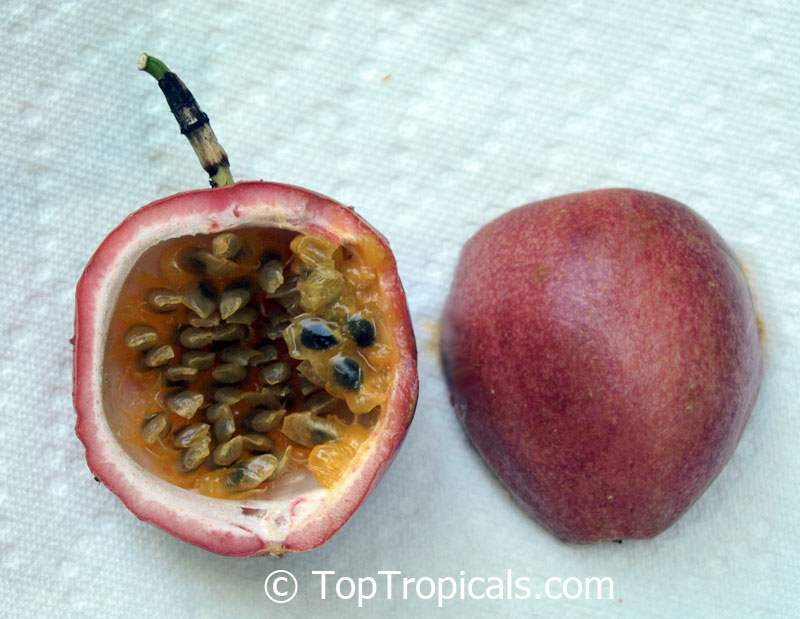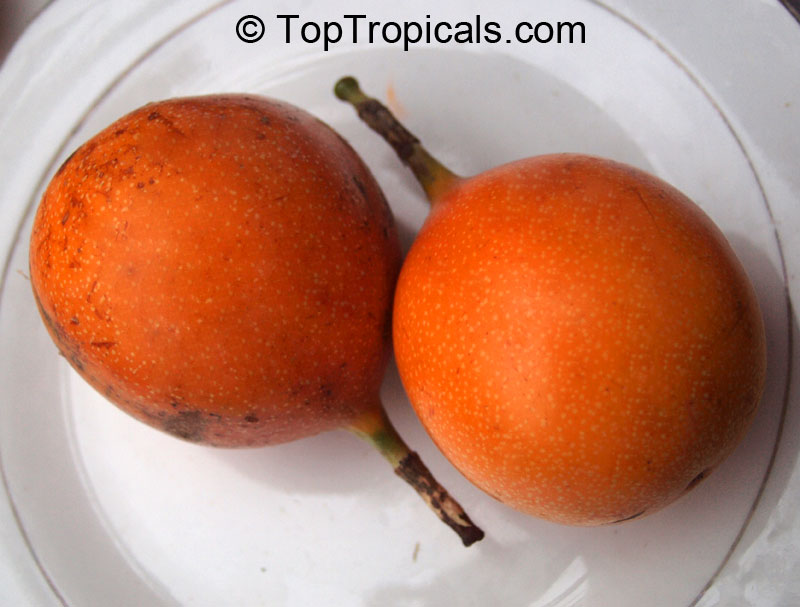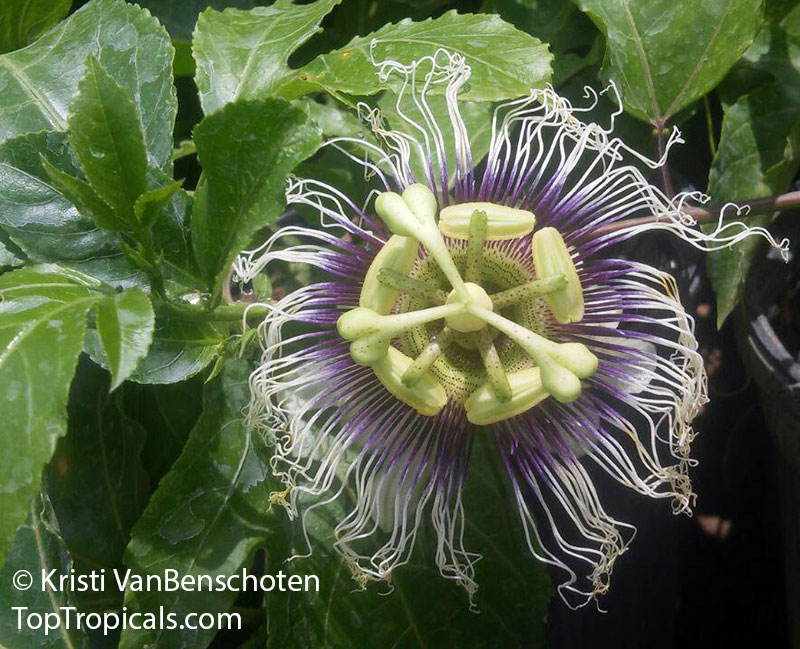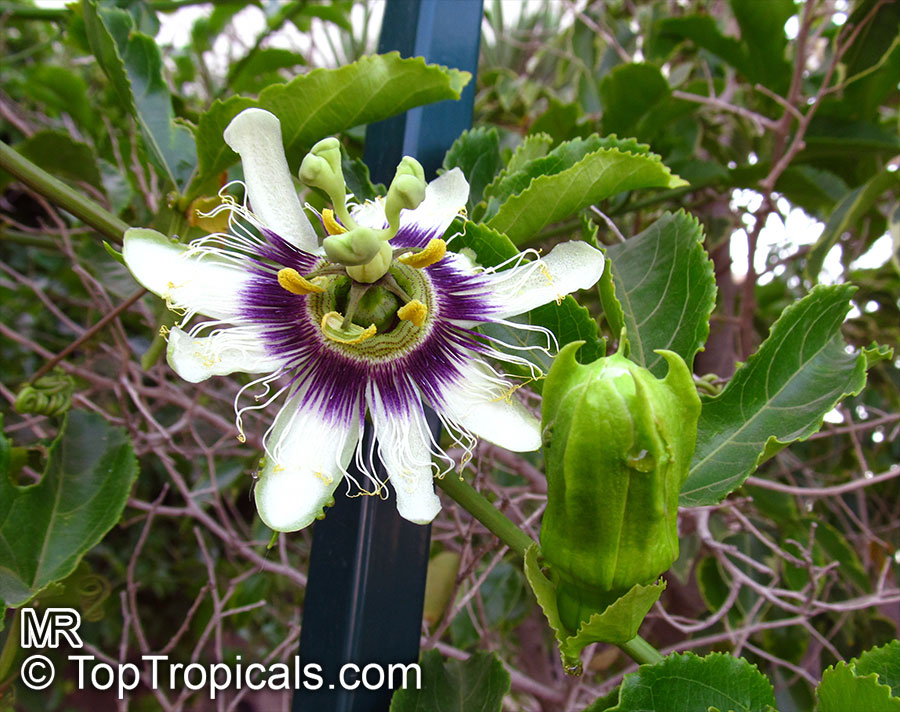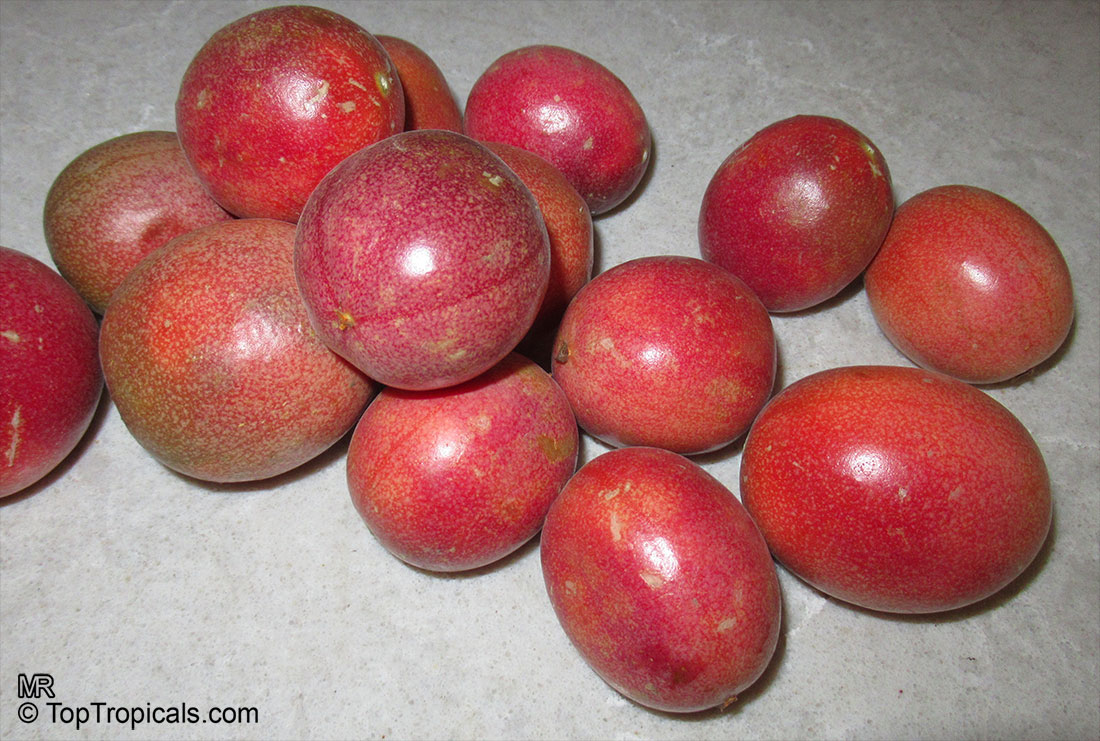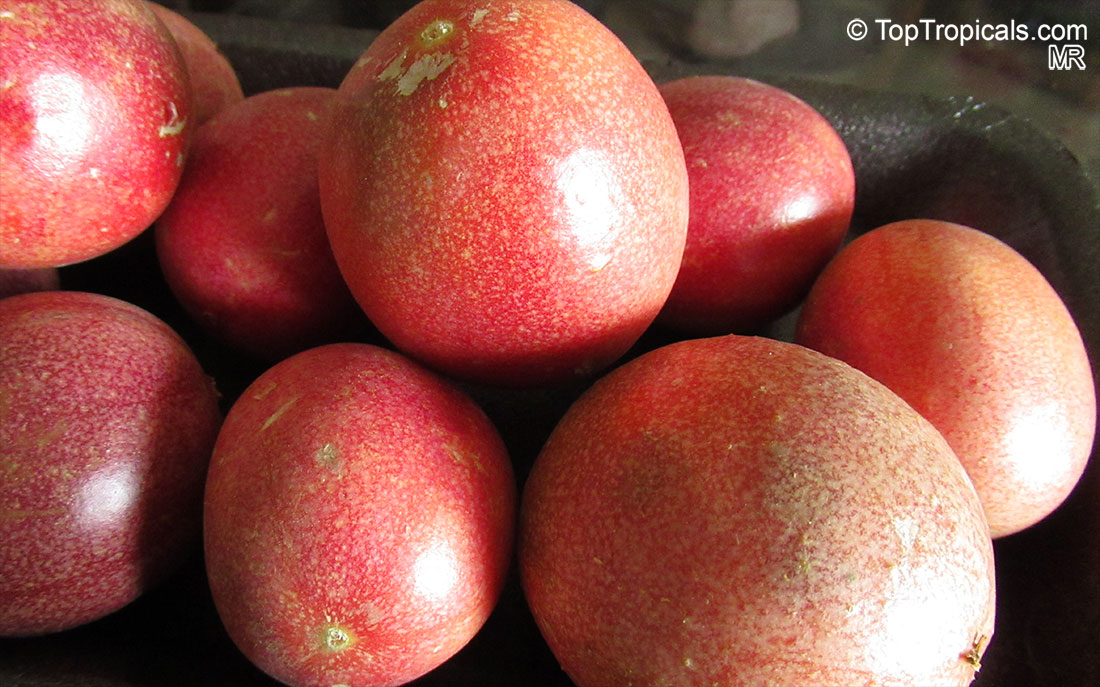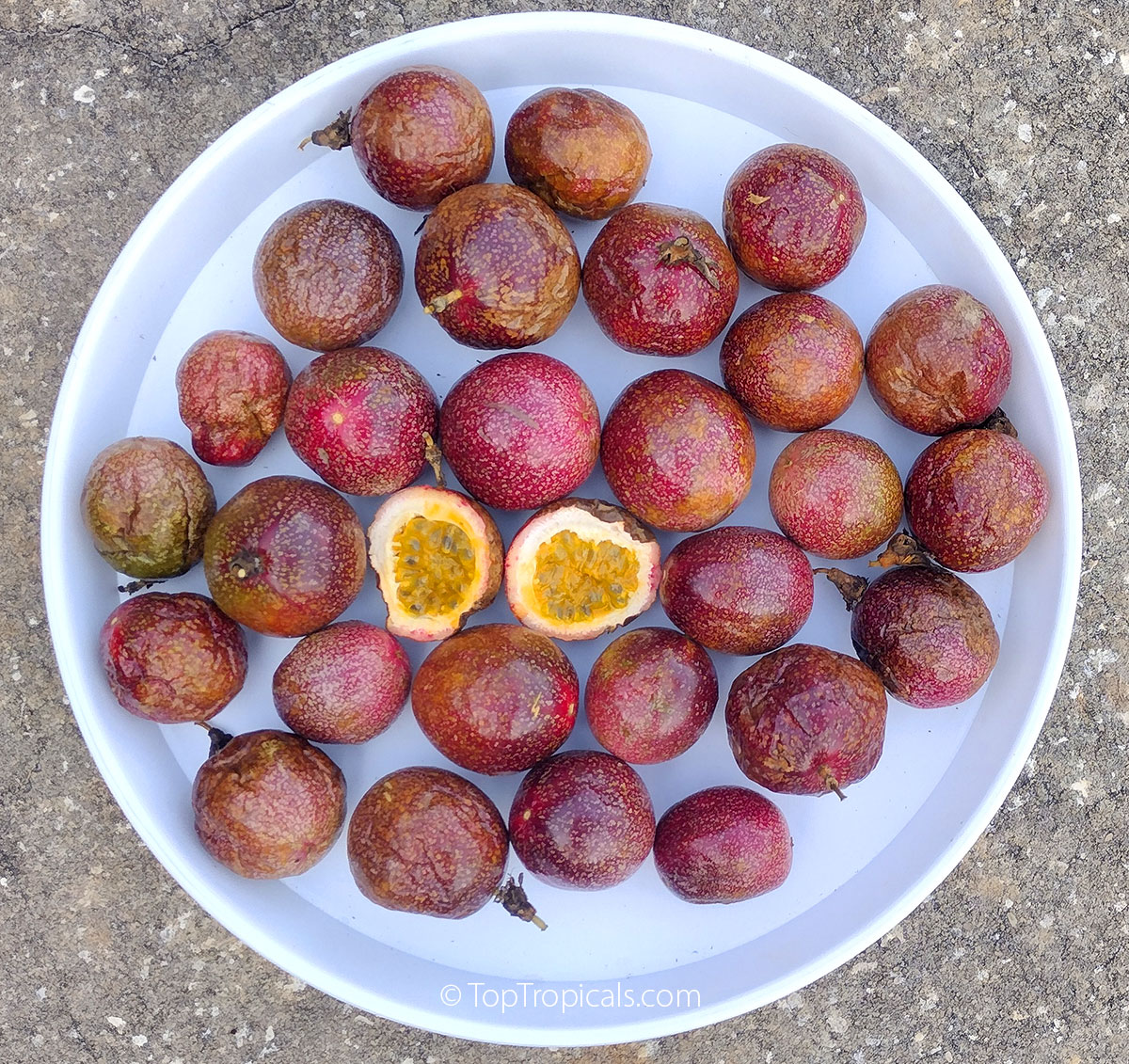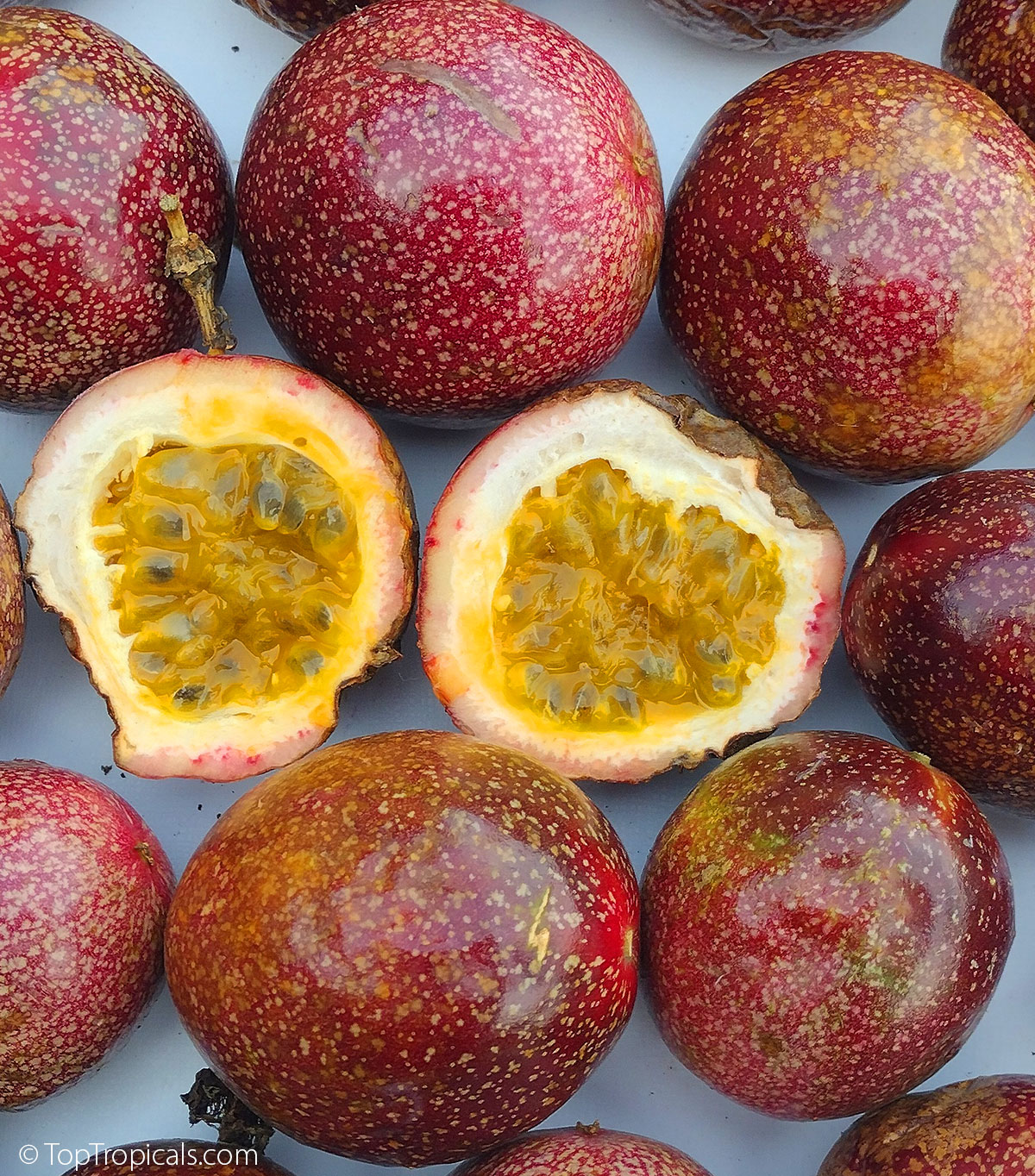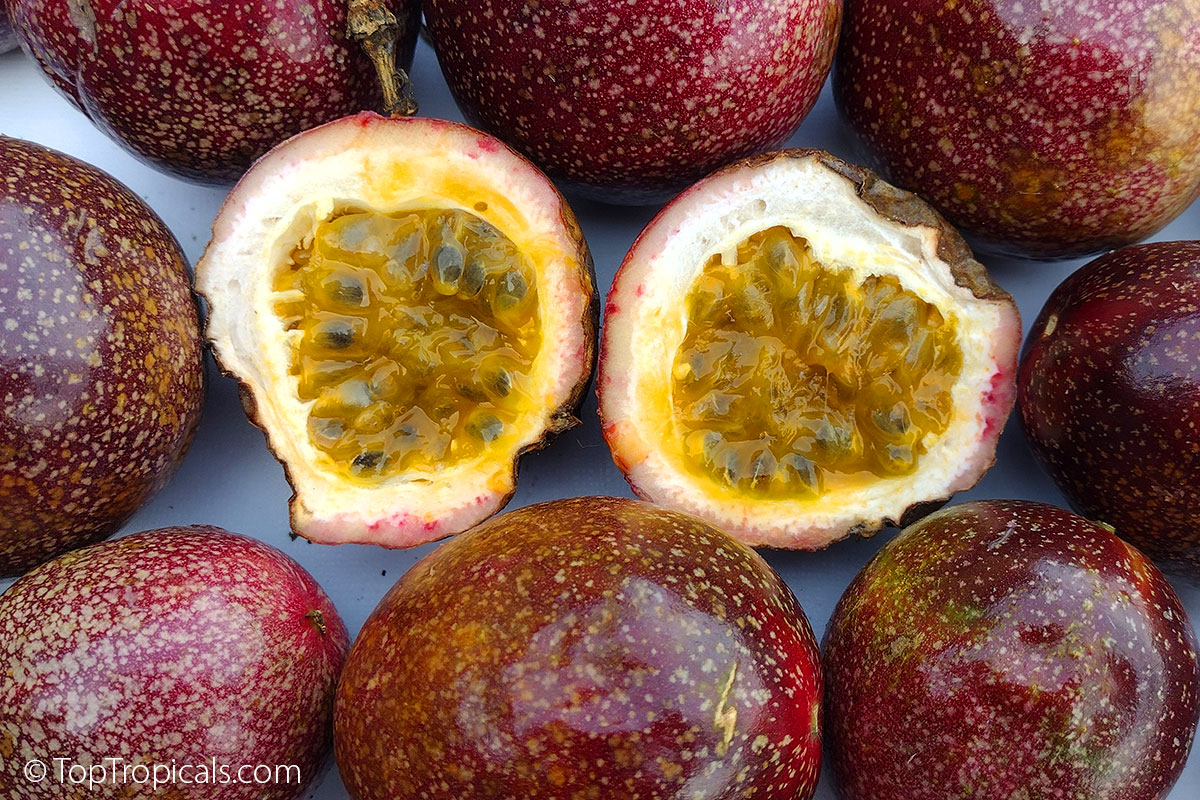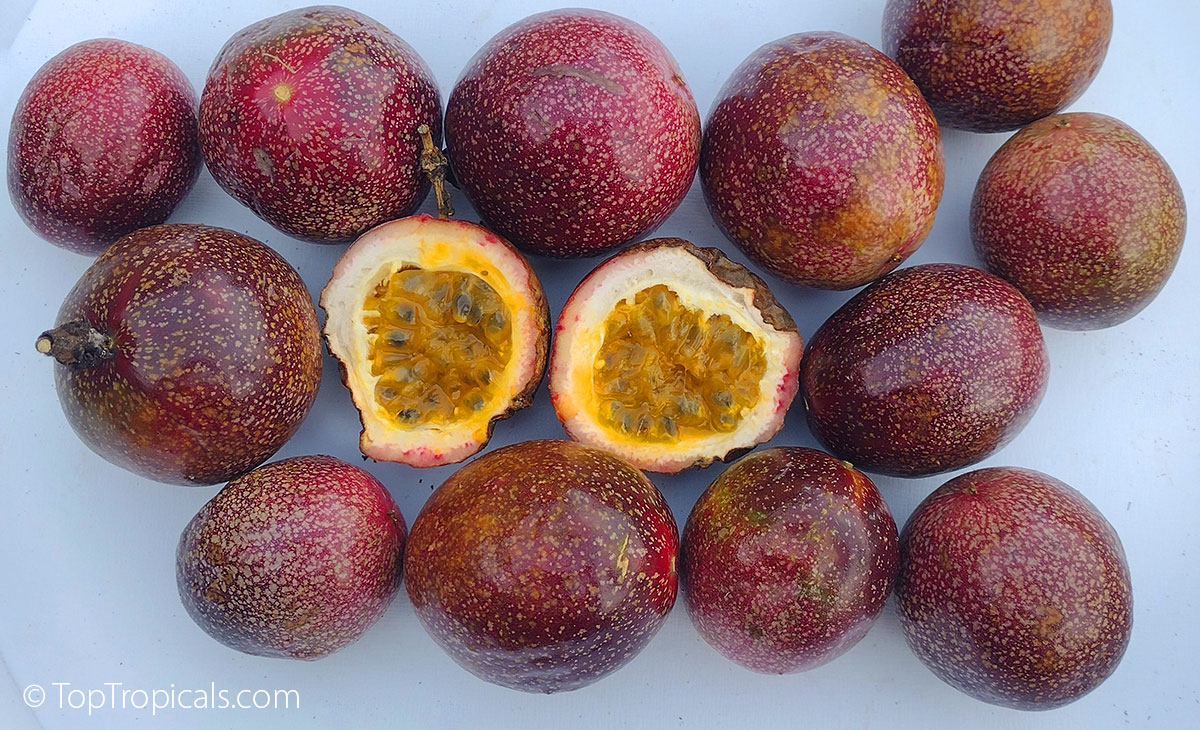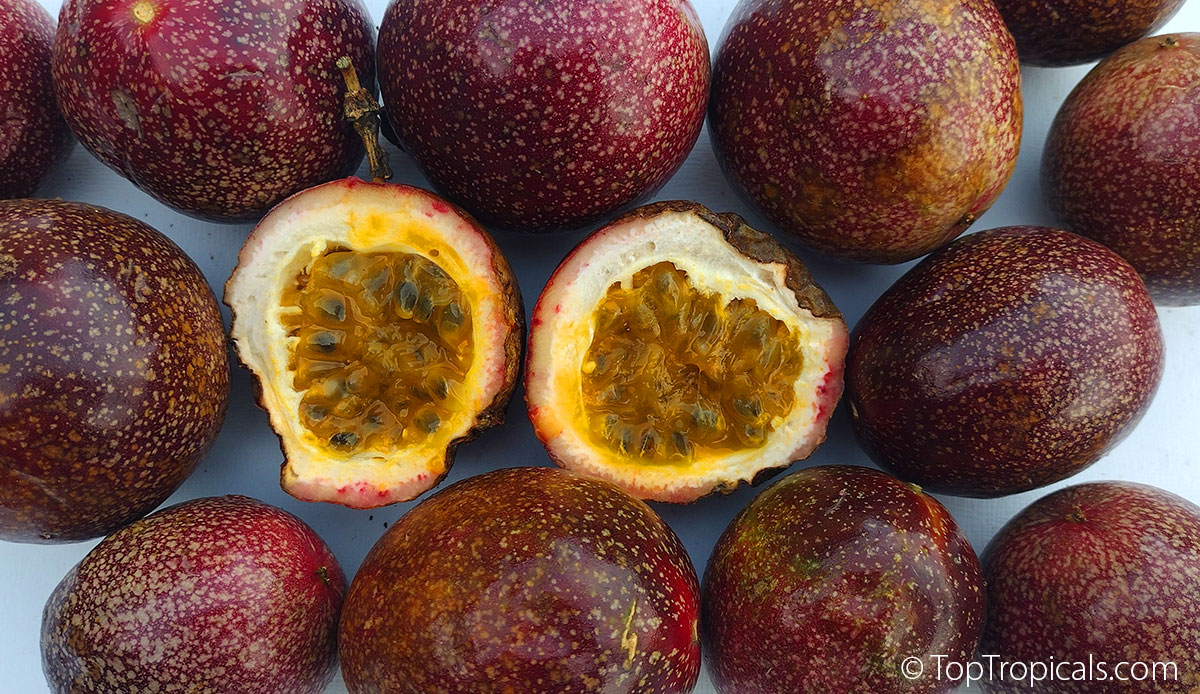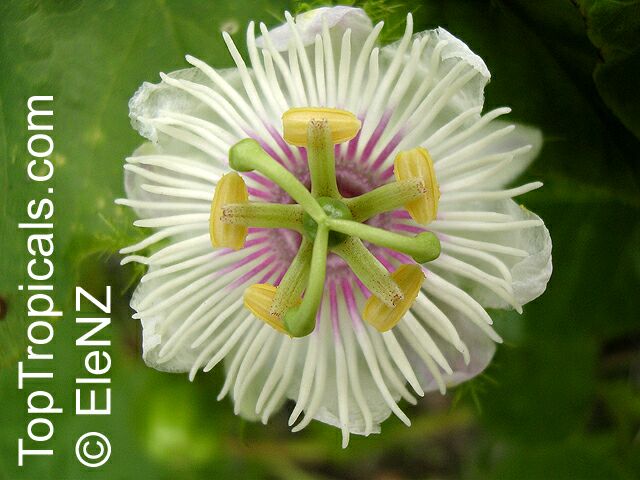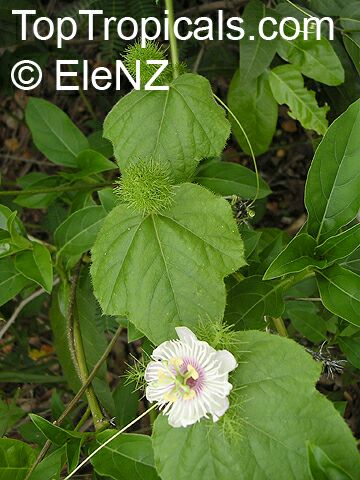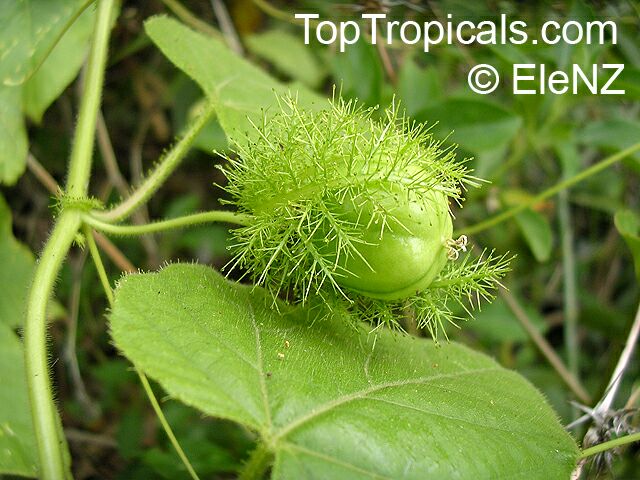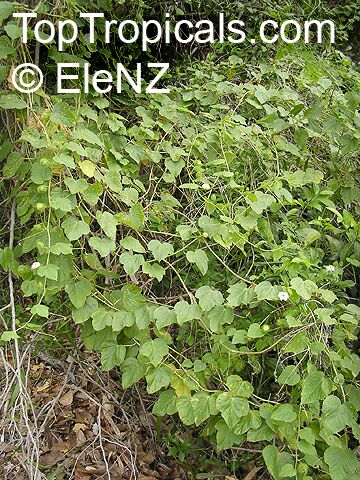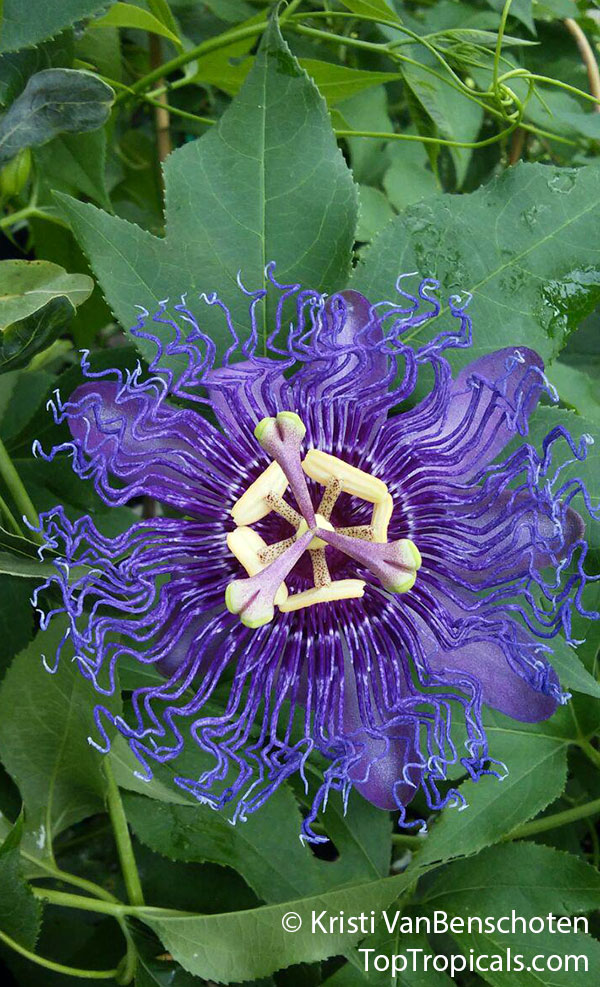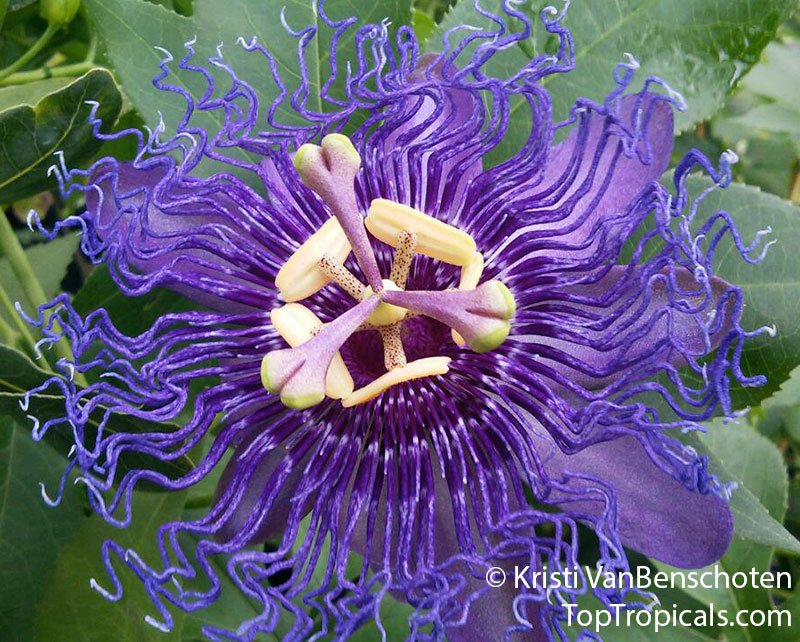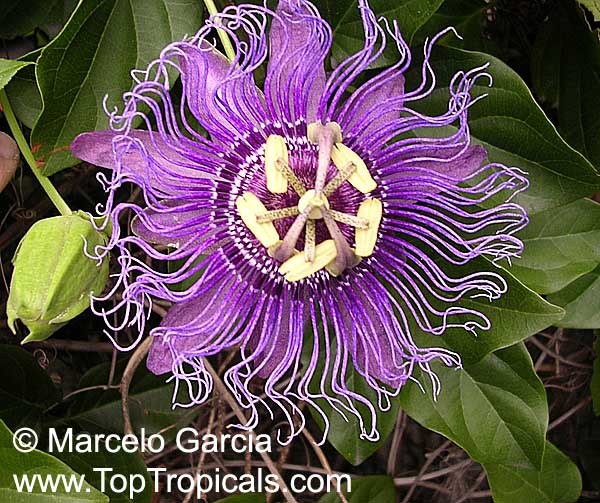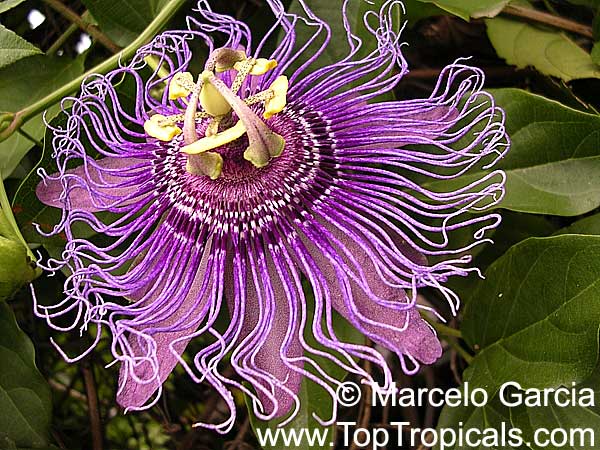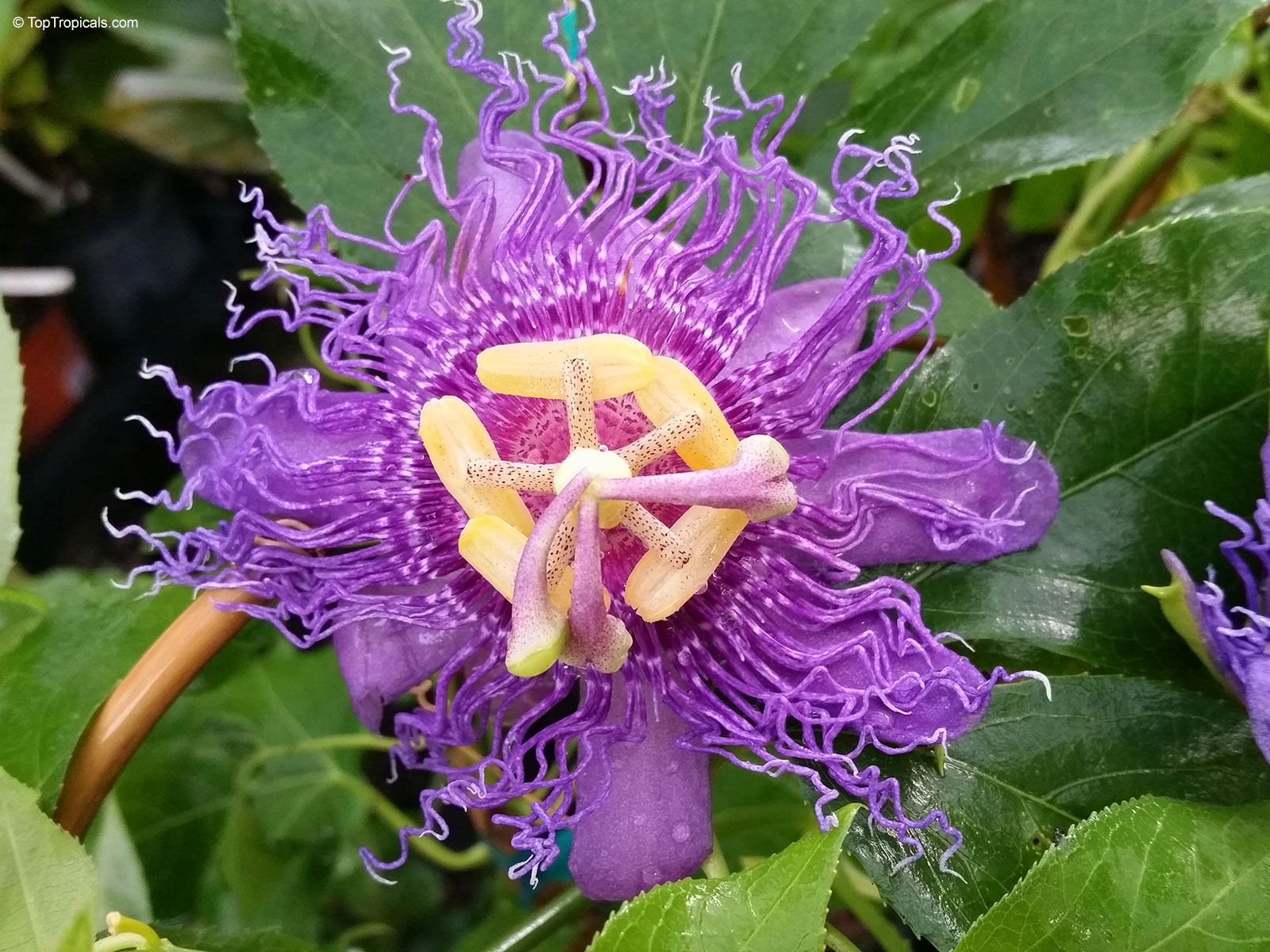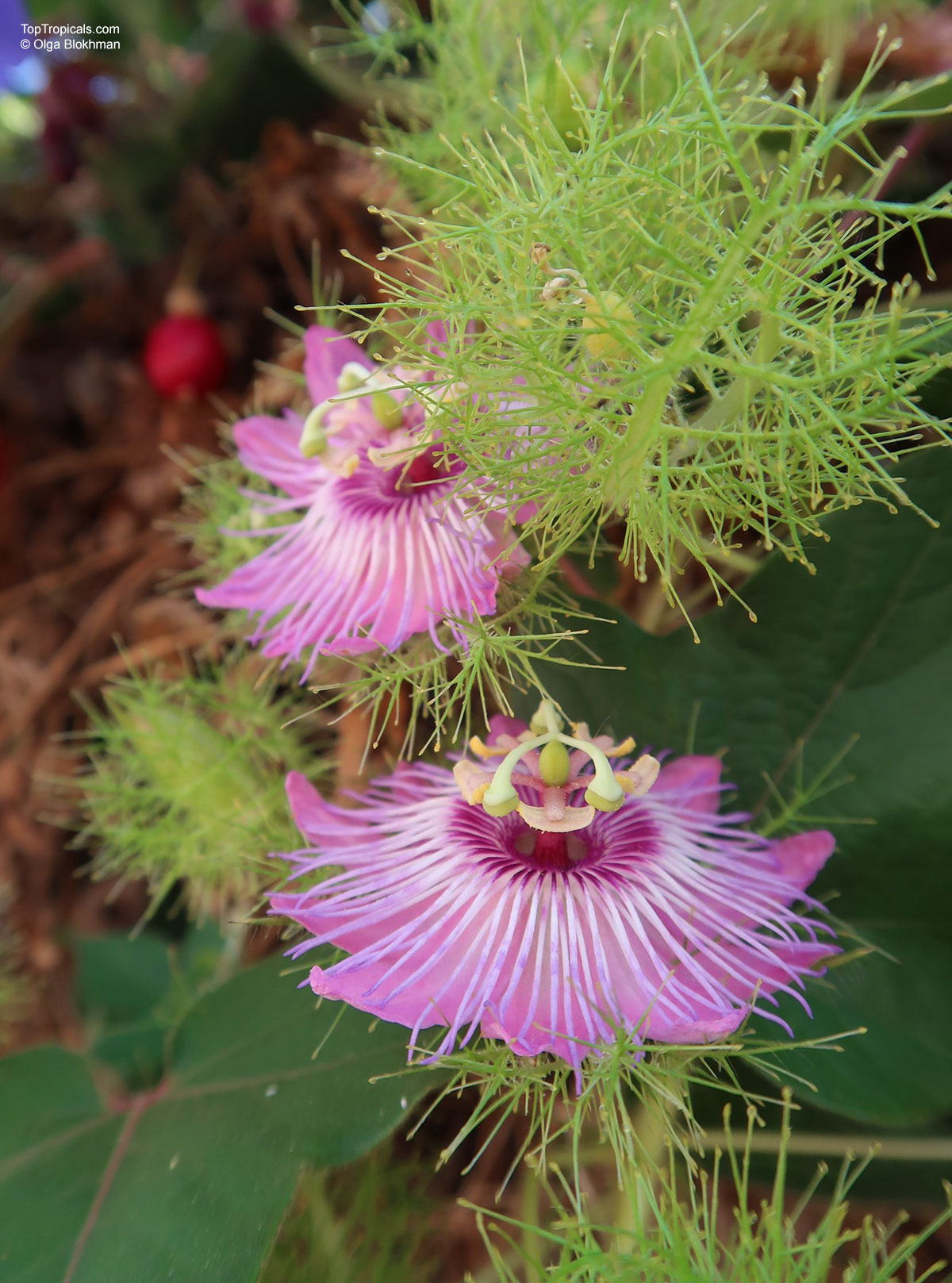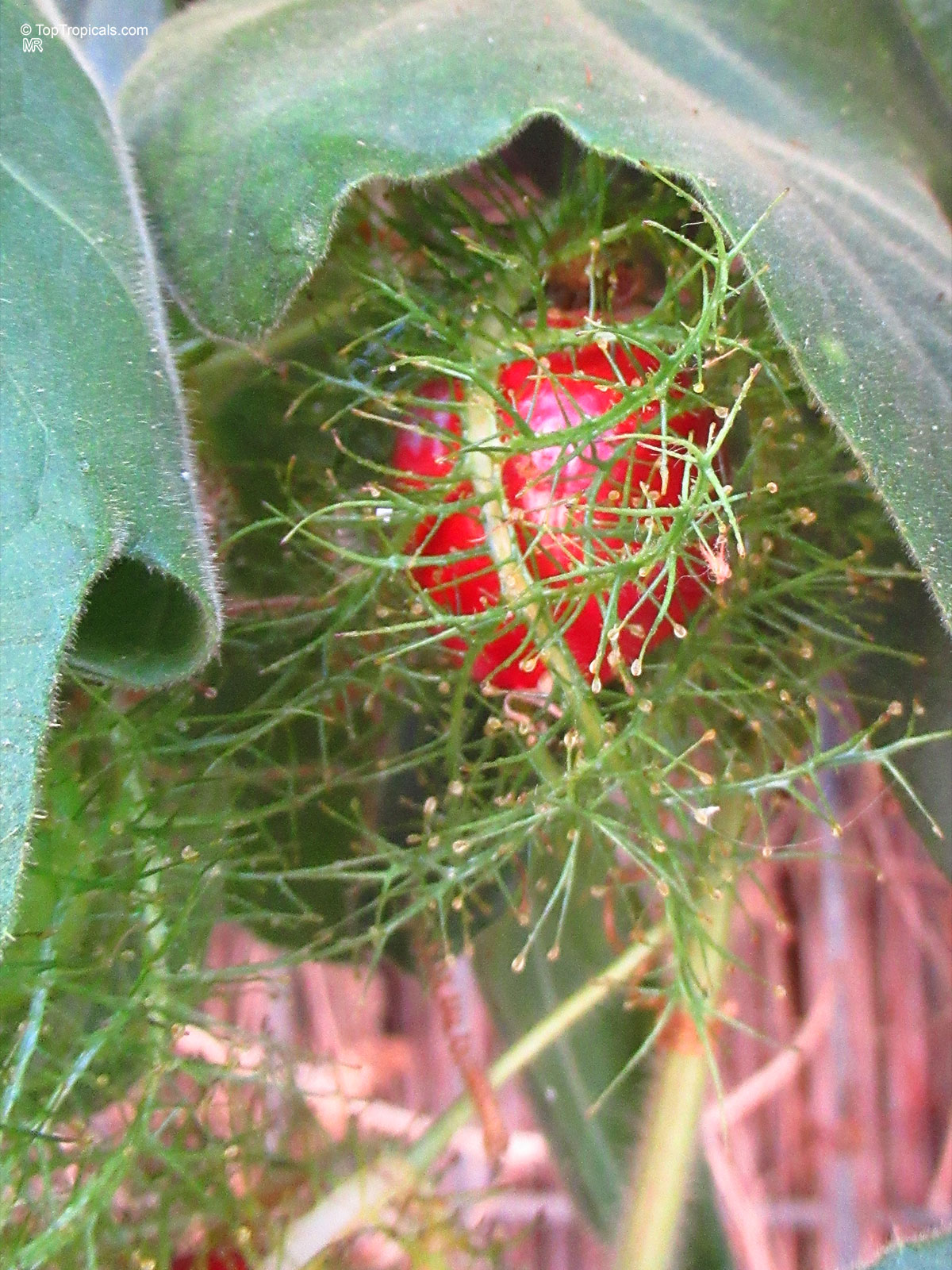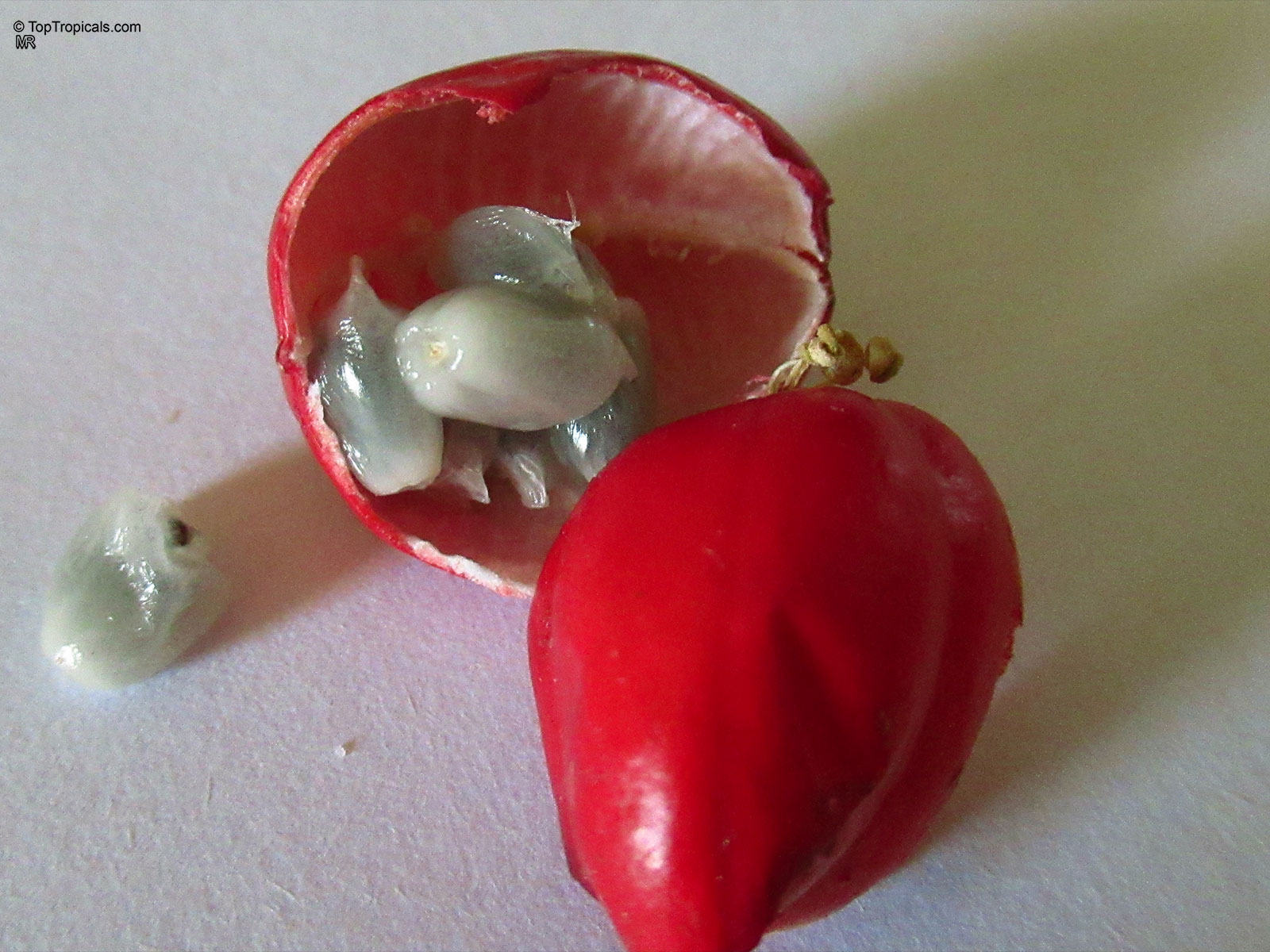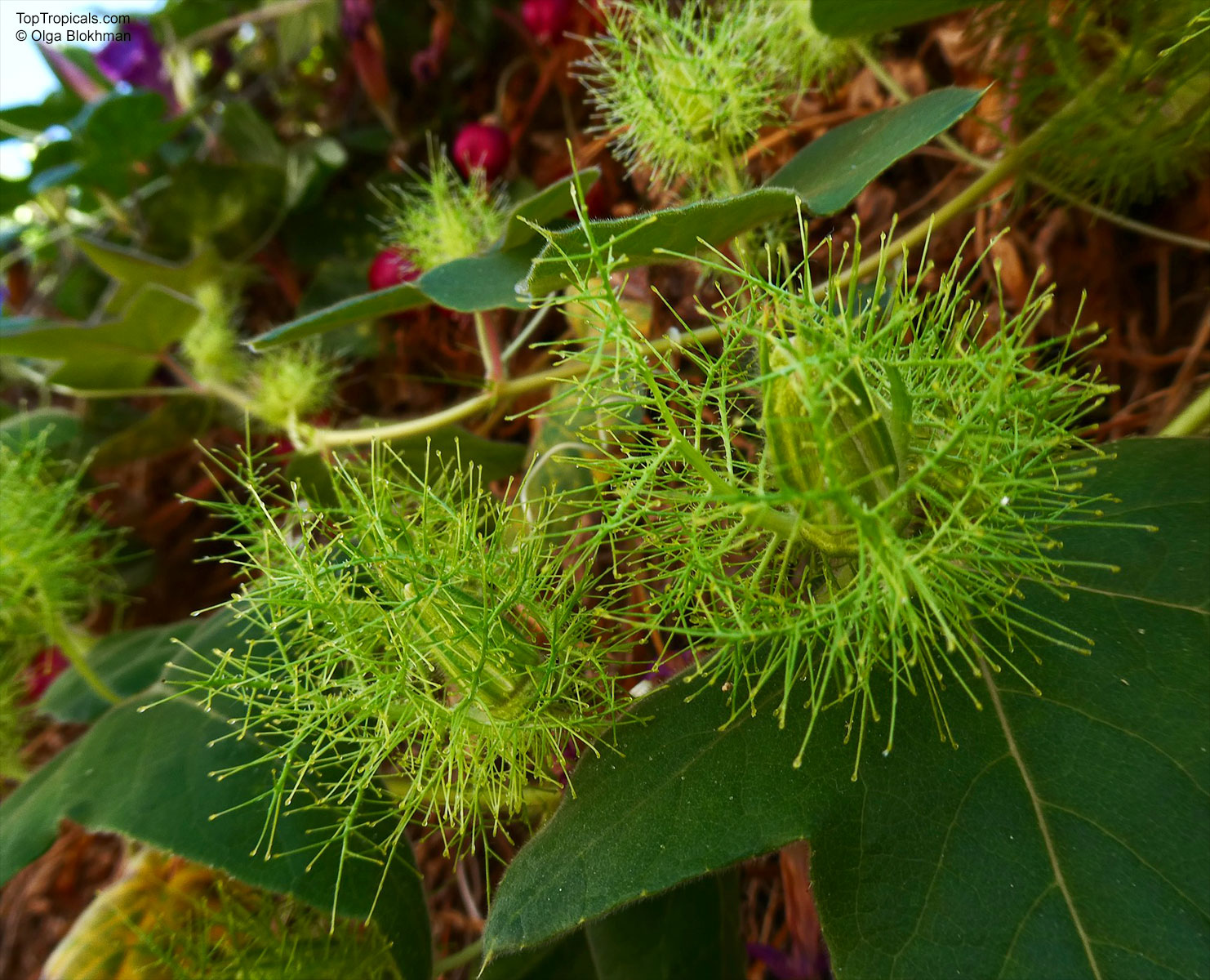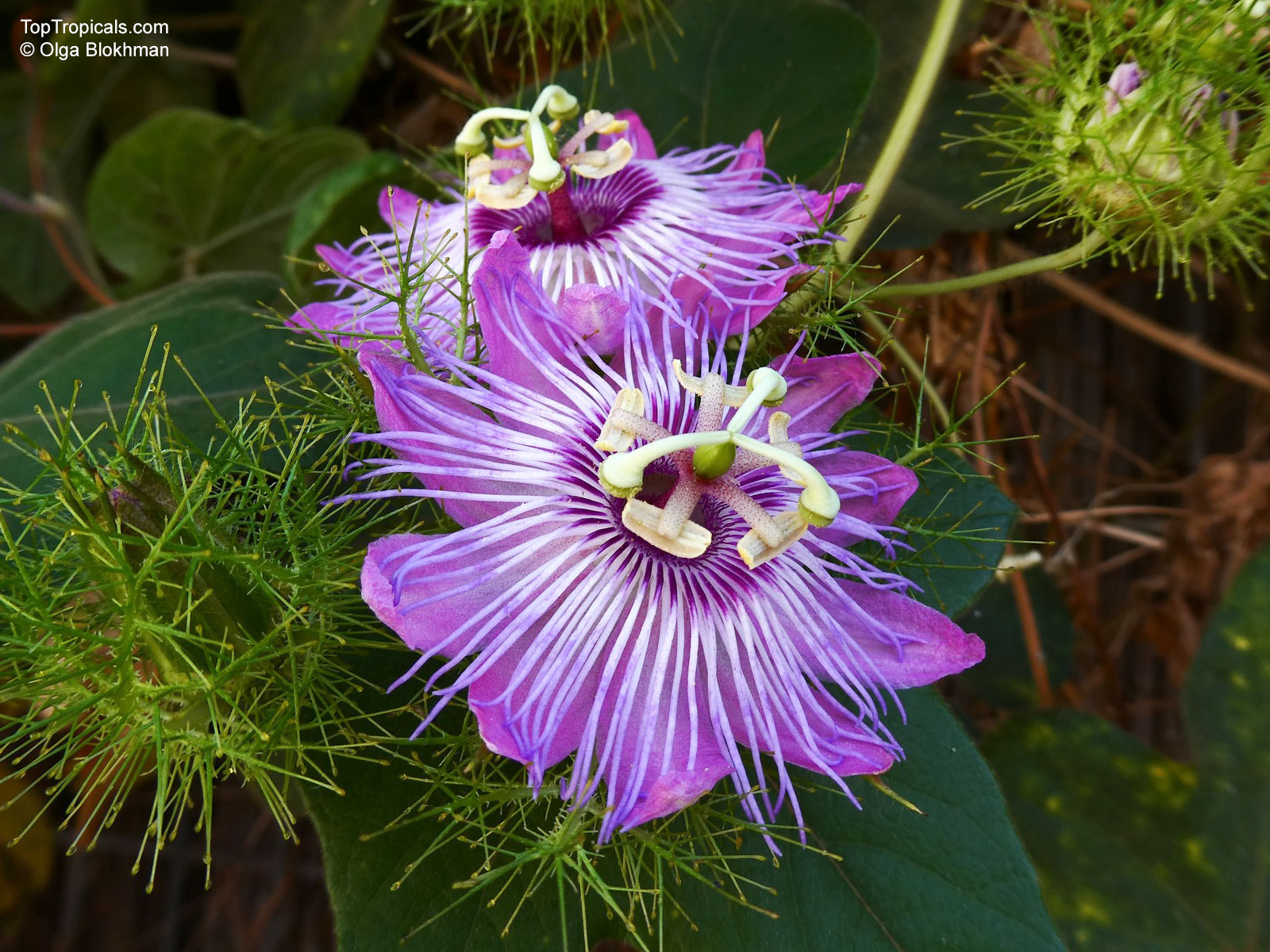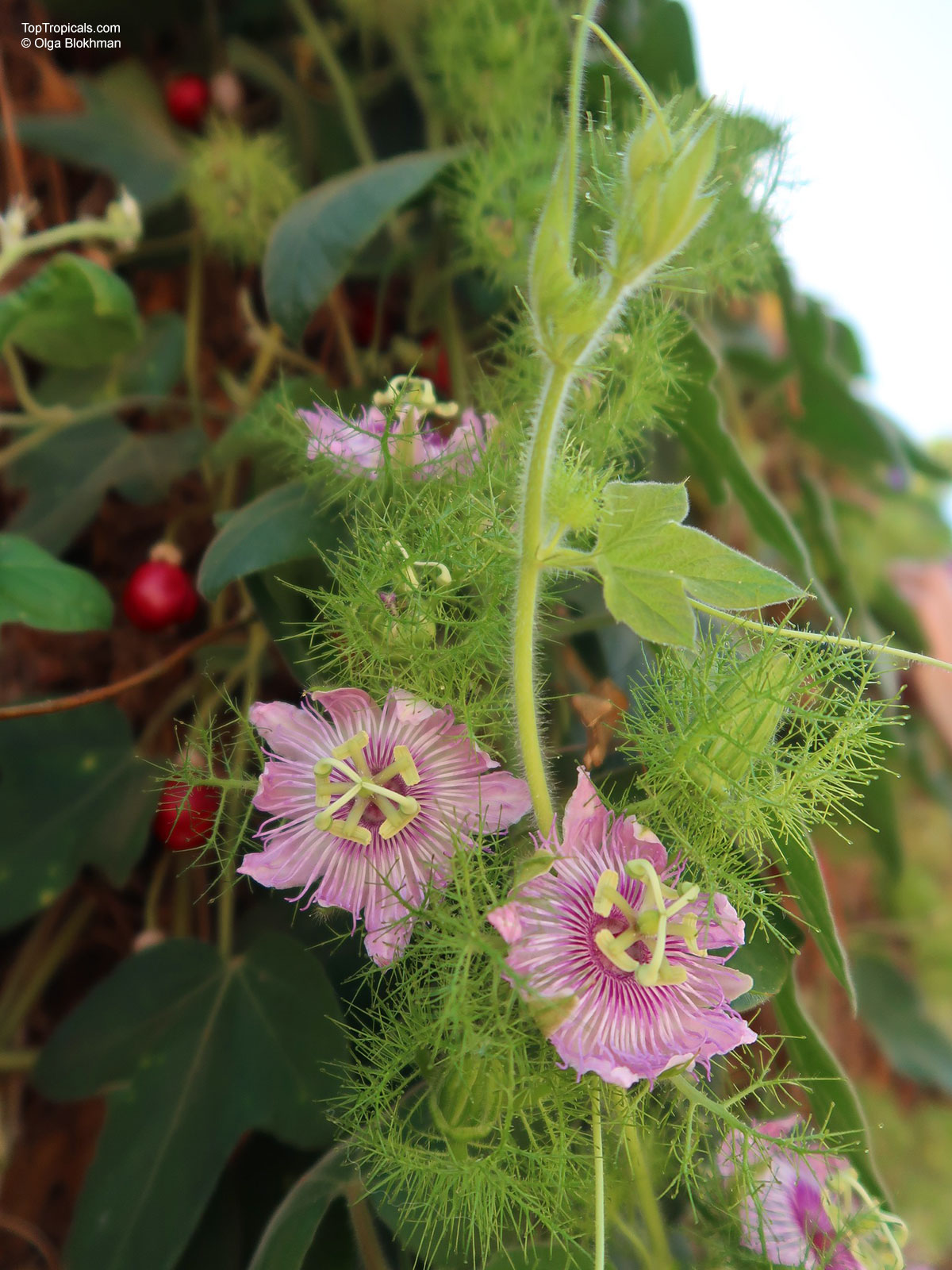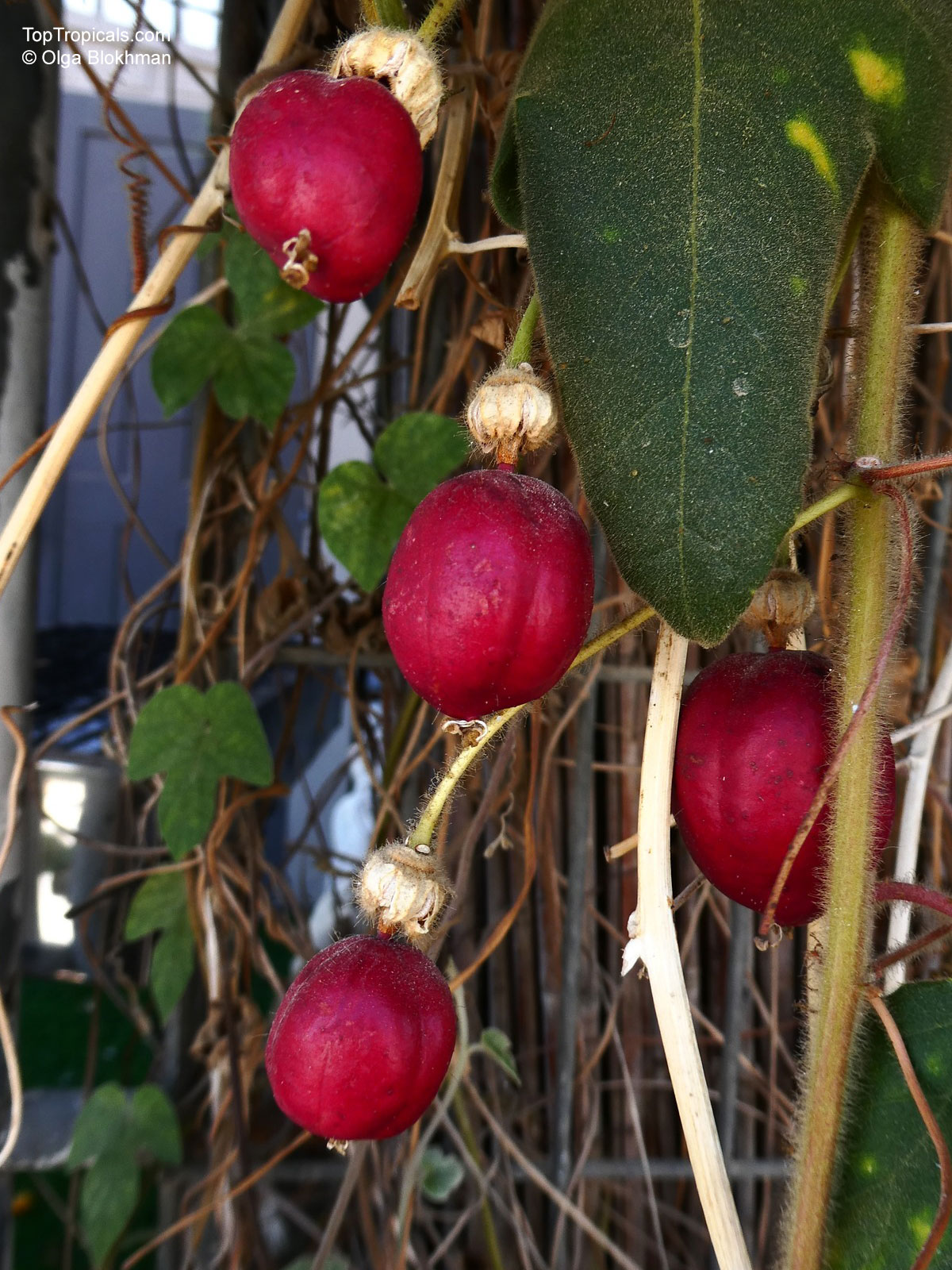Passiflora - Plant Encyclopedia Results
Top Tropicals Plant Encyclopedia
| Number of plants found: 29 | Next | 
|
Go to page: | 1 | 2 | 3 |
Botanical name: Passiflora alata
Common names: Winged-Stem Passionflower, Fragrant Granadilla
Family: Passifloraceae
Origin: Brazil








Passiflora alata is a vine or creeper, native to Brazil and widely grown as an ornamental in warm temperate climates. It is best grown in full sun to semi-shade, although it can tolerate light shade in warmer climates. The plant requires regular watering and well-drained soil for best results. The plant will flower and bear fruit better when planted in warm temperatures.
The flowers of Passiflora alata are exceptionally beautiful, with their bright red, crimson and vinous petals, white and purple filaments, and highly fragrant scent. It is not surprising that these flowers attract a lot of butterflies and hummingbirds. The beautiful blooms are soon followed by oval-shaped, yellow to bright orange fruits that are up to 4″ long. The flesh of the fruit is light orange, slightly acidic and very tasty. Passiflora alata fruits are edible and have several health benefits. They are rich in antioxidants and can help reduce inflammation.
It is possible to grow Passiflora alata in cooler climates, provided that the plant is protected over winter and is planted in a pot. For pot-grown plant, mulch will be beneficial to keep the soil warm. In pots, the plant may produce fewer fruits than when planted in a warm and sunny spot. However, when it fruits, each plant can yield an abundant harvest of up to 50 fruits per season. The fruits are rich in Vitamins A, B and C and can be consumed fresh or used to make jams or jellies.
Botanical name: Passiflora caerulea
Common name: Common Passion Flower
Family: Passifloraceae
Origin: South America









A woody vine capable of growing to 15-20 m high where supporting trees are available. The leaves are alternate, palmately five-lobed (sometimes three or seven lobes).
The white and purple-blue flowers which appear in summer may be as large as 4 in (10.2 cm) across. The fruit is an oval orange-yellow berry.
Numerous crosses have been made between P. caerulea and Passiflora racemosa, Passiflora alata, and Passiflora Amethyst.
Botanical name: Passiflora citrina
Common name: Yellow Passion Flower
Family: Passifloraceae
Origin: Central America






This is a beautiful and unusual vine or creeper that is native to Central America. Passiflora citrina (Yellow Passion Flower) is a vine or creeper that grows in USDA Zone 9-11. Its attractive foliage with flame-like yellow stripes adds to the overall beauty of the plant. The small, star-like yellow flowers of the Passiflora citrina bloom throughout the year. It prefers full sun to semi-shade, and requires moderate water. However, it is important to note that its big leaves need more water as compared to other plants.
When grown in pots in chilly regions, Passiflora citrina requires special care. During winter, it should be moved inside to protect it from frost. The pots should be placed near a bright window, where the soil can be kept moist. It should be watered regularly, but the amount of water should be reduced during cold season. Feed the plant with a general-purpose fertilizer at the end of winter or early spring when the temperature starts to rise.
Passiflora citrina is considered an excellent ornamental plant. It is extremely attractive to butterflies and hummingbirds and its bright yellow-orange flowers add a splash of color to any garden. So, if you are looking to add a unique touch of vibrancy to your garden, the Passiflora citrina is an ideal choice.
Botanical name: Passiflora coccinea
Common name: Red Passion Flower
Family: Passifloraceae
Origin: South America
Hardiness: 30°F







Passiflora coccinea is best known for its flowers, which are large, light burgundy-red, with ten petals and a prominent, dark red and white striped corona. The stamens and style and greenish-yellow and stick out prominently. Fruit is edible, but rarely produced.
Passiflora coccinea (Red Passion Flower) is a tropical, tendril-climbing, evergreen vine boasting incredibly showy scarlet-red flowers, 3-4 inches across, adorned with white, purple, and yellow crowns. The ravishing blossoms are followed by egg-size, 2-inch across, edible and tasty passion fruits. They first appear green, striped, and mottled before turning golden yellow when ripe. The foliage consists of single, oblong, medium green leaves which create a perfect backdrop for the flowers.
Red Passion Flower can bloom throughout the year, but its peak season is in summer and fall.
Thrives in full sun or part shade, in fertile, moist, well-drained soils. Water freely when in growth and keep just moist in winter. Provide support for climbing stems and shelter from cold, drying winds. Best flowering occurs in full sun, but this flowering vine tolerates light shade.
Easy to grow, this Passion vine can quickly grow up to 10-12 feet long. Don't try to train your Passion Flower to be too neat and compact. The branches allowed to hang loose and droop a bit will be the ones most inclined to flower.
Excellent choice for trellises, walls, fences, or arbors. Perfect in wall-side borders, city gardens, cottage gardens, Mediterranean gardens, and containers. This trouble-free climber clings with tendrils so won't damage brickwork or fences!
Butterflies and hummingbirds are extraordinarily fond of Passion Flowers.
This vine blooms on new growth and should be pruned in late winter or early spring. No regular pruning is needed. However, trimming may be required to keep it to the space available, removing as much from the longer shoots as necessary.
Close related to Passiflora Lady Margaret and Passiflora vitifolia, but leaves have a different structure (oval rather than divided). The evergreen leaves are obovate in shape and have doubly serrate margins.
Botanical name: Passiflora colinvauxii
Common name: Colinvaux's Passion Flower
Family: Passifloraceae
Origin: Galapagos








A fast-growing vine with bat-shaped leaves. It flowers profusely in summer to autumn and smells of honeysuckle, which attracts bees.
Botanical name: Passiflora coriacea
Common names: Wild Sweet Calabash, Bat leaved Passion Flower
Family: Passifloraceae
Origin: Central and South America







Native to Central and South America, this captivating vine or creeper is found in a variety of habitats and thrives in USDA Zones 9-11. It is a vigorous grower and will reach up to 10 feet once established.
The evergreen foliage of Passiflora coriacea is black-green in color, a striking contrast against its white and off-white flowers. The very unique blooms of this species feature an intricate design with filaments and a crown of yellow and orange and can reach up to 4 inches in size. The long petals and stamens of the flowers make them especially attractive to butterflies and hummingbirds.
This species prefers full sun and does best in regular water, although once established it will tolerate a moderate watering regime. Passiflora coriacea makes an excellent choice for growing in a pot, and can even withstand cooler temperatures in regions where freezing temperatures are common.
To ensure this plant thrives, it is important to use a container with plenty of drainage and provide moderate water and full sun. In cold regions, it is important to bring the pot indoors during winter, as temperatures below 32 F degrees can be damaging to the plant. For best results, use a good quality potting soil and a well-draining container to help protect roots from damage due to excessive moisture.
Botanical name: Passiflora edulis
Common names: Passion Fruit, Parcha, Maracuya, Granadilla
Family: Passifloraceae
Origin: Brazil, Paraguay, Argentina







Varieties: Possum Purple, Quadrangularis. Season: July to October. Rampant woody vine that climbs with tendrils. Evergreen leaves, deeply 3 lobed, 3 to 8 deep green, shiny above, paler and dull beneath. Single fragrant flower 2 to 3 wide is borne at each node on the new growth. Showy, intensely colored flower produces the nearly round to ovoid fruit with a tough rind which is smooth and waxy. Pulp within is highly aromatic orange-colored with hard dark brown or black seeds. Flavor is appealing, musky, guava-like sub-acid to acid. Use mulch and plenty of organic matter in the soil to reduce nematode damage. Eaten fresh, used in juice processing, preserves and wines. There are more than 400 species of Passiflora, but only some provide the fruit used for jellies or desserts. Passion fruit can be started from seed as soon as the fruit is available. Plant seed in a light soil and provide high humidity and warmth (78 F). Germination should start in a month or less. When the seedling is 2 to 3 inches tall, put it in an individual pot. Keep it in a bright place with moderate temperatures, avoid extremes.
Recommended Fertilizer: SUNSHINE C-Cibus - Crop Nutrition Booster
SUNSHINE-Honey - sugar booster
Ordering seeds info
RECOMMENDED SUPPLIES:
Seed Germination Mix #3, professional grade
SUNSHINE-Epi - Seeds and cuttings booster
SUNSHINE Bombino - Young Plant Booster
Recommended Fertilizer: SUNSHINE C-Cibus - Crop Nutrition Booster
SUNSHINE-Honey - sugar booster
Recommended Fertilizer: SUNSHINE C-Cibus - Crop Nutrition Booster
SUNSHINE-Honey - sugar booster
Botanical name: Passiflora foetida
Common names: Wild Maracuja, Love-in-a-mist, Sneki Markusa, Stinking Passion Flower, Tagua Passion Flower, Granadilla colorada, Pop Vine
Family: Passifloraceae
Origin: Amazon River Region, Brazil







Passiflora foetida is a climbing and flowering perennial vine that has pink flowers and small edible fruits. These orange fruits, although much smaller, taste the same as those from passiflora edulis. The seeds are very small and black, embedded in juicy pulp; the stems and leaves are covered with yellow hair. The leaves, which are three-lobed, have an unpleasant odor when crushed. There are some medicinal applications of Passiflora foetida.
In Suriname's traditional medicine, a tea of the leaves is used as an expectorant and for nervous disorders.
Botanical name: Passiflora incarnata x cincinnata
Common names: Passiflora 'Incense', Fragrant Passion Flower
Cultivar: Incense
Family: Passifloraceae
Hardiness: 30°F







It needs moderate water and should be watered regularly during dry spells. Passiflora 'Incense' is a hybrid vine or creeper composed of Passiflora incarnata x cincinnata. It produces blue, lavender, and purple flower that have a wonderful fragrance, attracting butterflies, such as Gulf Fritillaries, and hummingbirds to the garden. In USDA Zones 9-11, it can be planted outdoors in the ground, or in a pot in cold regions.
When growing Passiflora 'Incense' in pots, it is important to use a high quality potting soil that drains well, and keep the soil lightly moist. Place the pot in a bright location with at least four hours of direct sunlight each day. In summer, water the plant once a week, allowing the soil to dry between waterings. During cooler months, water once every two weeks. Prune after flowering to keep the plant in shape and encourage new growth. Feed with a balanced fertilizer, once a month during the growing season.
Recommended Fertilizer: SUNSHINE Megaflor - Bloom Nutrition Booster
Botanical name: Passiflora lanuginosa
Common name: Woolly Passion Flower
Family: Passifloraceae
Hardiness: 35°F





Passiflora lanuginosa (Woolly Passion Flower) is an unusual tropical vine admired for its striking violet flowers and distinctive spiny, green-haired buds. The blooms are rich purple with lighter filaments and a white center, appearing delicately fringed and fragrant, about 3 inches across. Each bud and young fruit is surrounded by a soft cage of fine green bristles that gives the plant a whimsical, almost otherworldly look. The red, egg-shaped fruits are about 1 inch long and decorative among the dense foliage. The fruit is ornamental only and not considered edible. The vine grows rapidly, clinging to supports with tendrils, and makes a spectacular ornamental addition to fences and pergolas.
Native to tropical South America, this species thrives in warm, humid conditions and performs best in full sun or partial shade with rich, well-drained soil. It flowers and fruits through the warm months and can be grown as a container specimen in cooler areas if protected from cold. Trees thrive in USDA Zones 10-11 and need protection from frost, with minimum tolerance down to about 35F.
| Next |  |
Use link to repeat this search:
https://toptropicals.com/cgi-bin/garden_catalog/cat.cgi?find=Passiflora&search_op=and&keyword_op=and&language=e&number=10
&no_change_lang=1&user=tt&sale=1&first=0
